You can choose your own adventure when it comes to trekking in Chile, but if you like to plan ahead, here’s our tried-and-tested 5 day/4 night, east-to-west, self-guided itinerary for hiking the W Trek Patagonia.
Torres del Paine National Park is a place so epic and otherworldly, its name is often spoken with a kind of hushed reverence. This vast and dramatic stretch of Chilean Patagonia is home to some of the most mind-blowingly beautiful scenery on Earth, and hiking the W trek is one of the greatest ways to immerse in it.
This is Patagonian hiking at its very best, but how you trek the W trail is entirely up to you.
You can go with a guide, or do the W trek self guided (in the warmer months anyway). You can stay in lodges and enjoy a cooked meal and a warm bed. You can carry your own gear and pitch your tent in one of the designated campsites along the way, or carry no gear and book a tent at each site. You can carry all your food, or add a half or full board meal package to your booking, or do a bit of both.
We opted to camp but rather than carry all the gear, we arranged for a pitched tent to be waiting for us each day. We packed food for most of the trek and booked a full board meal package (dinner, breakfast and packed lunch) at one of our overnight camping stays.
The direction you hike and the time you take to do the trek is also your call. As occasional hikers with temperamental knees, we opted for the typical self guided W trek itinerary of 5 days and 4 nights.
Many argue that hiking west to east, and saving the striking granite peaks of Las Torres for the last day is a fitting finale to this incredible hike. We took the opposite view though, starting with the awe-inspiring torres and hiking the W trek east to west so that we could tackle the toughest legs of the trail in the first couple of days, while we still had plenty of energy.
At the end of the day, no matter how you take on the W hike, you’re still trekking one of the most spectacular trails on the planet. And you’ll still get to enjoy the jaw-dropping vista of Las Torres. Twice even, if you’re keen.
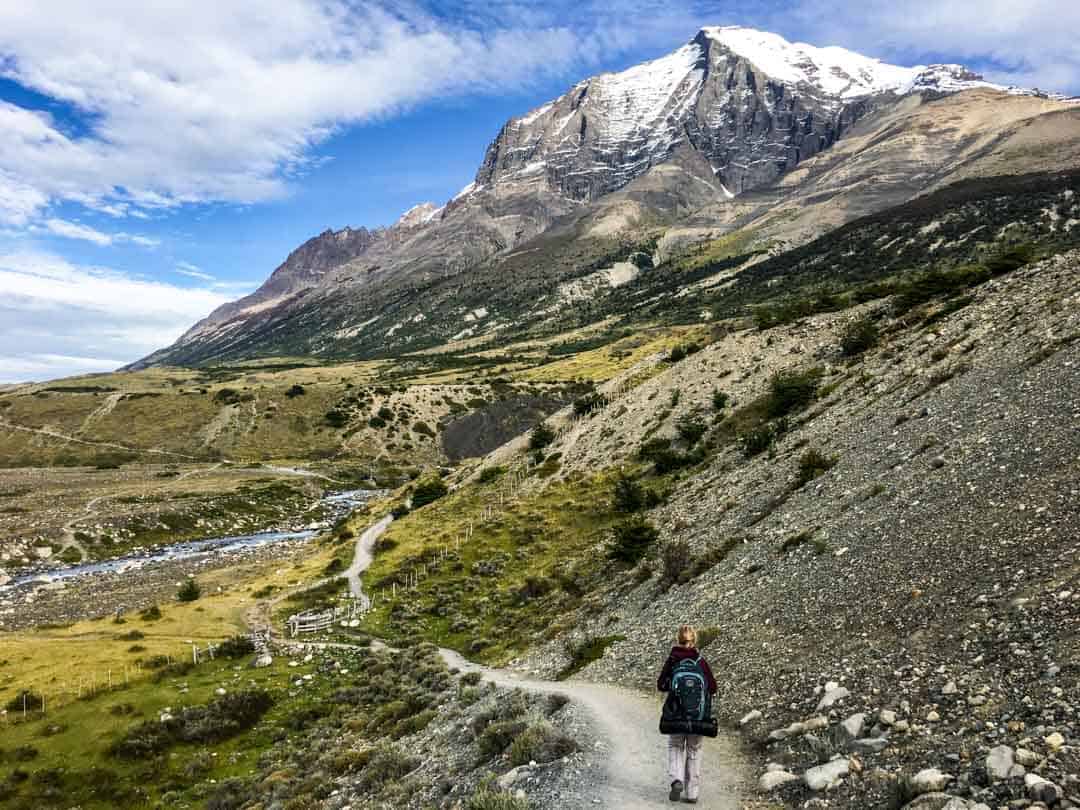
Hiking the W Trek Snapshot
Location: Torres del Paine National Park, Chile
Nearest town: Puerto Natales, Chile
Getting to and from the park: Torres del Paine is easily accessible by bus from Puerto Natales.
Park entry: Park entry tickets and overnight stays in the park (campsites and lodges) must be arranged before visiting the park.
Start and finish: The W Trek traverses a roughly w-shaped route through Torres del Paine National Park between Refugio Las Torres in the east and Refugio Paine Grande in the west. For this itinerary, we start in the east and hike west.
Distance: appx. 74 kilometres (46 miles) one-way
Time: This itinerary is 5 days and 4 nights
Difficulty: Moderately difficult, with some challenging stretches and steep climbs, plus highly changeable weather. We’re occasional hikers but with some preparation and a reasonable level of fitness, we found the W Trek very do-able (even if all our muscles were screaming for days afterwards!).
What’s in this post?
Preparing for hiking the W Trek Patagonia
What time of year is best for hiking the W?
Where to stay before and after the trek
Entry to Torres del Paine National Park
Booking Camping and Accommodation on the W Trail
Bus tickets to and from Torres del Paine
Packing for the W Trek
Our Self-guided itinerary for hiking the W Trail
Day 1 – Puerto Natales to Chileno via Las Torres
Day 2 – Chileno to Francés
Day 3 – Francés to Paine Grande via Francés Valley
Day 4 – Paine Grande to Grey
Day 5 – Grey to Paine Grande (and return to Puerto Natales)
This post contains affiliate links. If you choose to purchase through these links we may receive a small commission, at no extra cost to you, which helps us to keep this website running. Thanks for your support!
Preparing for hiking the W Trek Patagonia
We aim to fully check and refresh this post for each trekking high season (October to April). Things can change without notice though, so we recommend also visiting the links below for information while you’re planning and before you go:
- For the latest updates on requirements for travel to Chile, visit the official Chile tourism website.
- The W Trek is in Torres del Paine National Park, which is managed by the park agency CONAF. Visit the official park website for park entry information and more.
- When you arrive at Torres del Pine National Park and register for your trek, you’ll receive an information guide with a map showing the park’s trails, services and accommodations.
What time of year is best for hiking the W?
Patagonian weather will keep you on your toes no matter when you visit Torres del Paine National Park. Be ready for everything. However, there are two distinct periods to be aware of when planning your trip.
High Season – October to April
These are the warmer months in the southern hemisphere, and December to March is the busiest time of year to trek in the park, with visitation peaking over January and February. During this period, you can choose to do a self-guided hike or go with a guide.
If you’re travelling in high season, and particularly if you’re planning to visit during the peak months, be sure to reserve your place in the lodges or campgrounds as far in advance as possible. Torres del Paine is now one of the most popular places to trek in Chile and overnight places book up very quickly.
We hiked the W trail towards the end of March, and while sections were busy, like the path to Las Torres, there were stretches where we wouldn’t see more than a handful of people in hours.
That said, despite making our campsite reservations months prior to our visit, we initially struggled to find availability and had to change our trekking dates to suit what we were able to book.
Low Season – May to September
Many people say winter is even more magical in Torres del Paine.
The park entry fee drops during the low season and you’ll find far fewer people in the park. But temps will also be lower, daylight hours are shorter, rain is frequent and there can be snow and ice. Many of the mountain trails are closed, as are a number of the mountain lodges and services. Trails that are open can close suddenly due to weather (though that can happen at any time of the year). Transport services pause over this period as well.
Most importantly, to do the W Trek or hike to the base of Las Torres during the winter season, you must have a qualified guide. This is for visitor safety and the period typically runs from May until August/September. The O circuit remains closed until October. Check the CONAF website for more information if you’re planning to visit over this time.
The bottom line: No matter what time of year you visit Torres del Paine, given the changeability of the weather there, you should check in with park agency CONAF for latest updates and closures.
Where to stay before and after the trek
The nearest major population centre, and the main jump-off point for a Torres del Paine trek is Puerto Natales, a low-key Patagonian town hugging the shores of the picturesque Última Esperanza Sound.
The drawcard of Torres del Paine’s trails has seen Puerto Natales develop a buzzing trekker scene.
We suggest giving yourself a couple of days in Puerto Natales before your trek to get organised, shop, hire any gear you need, and sort out transport to and from Torres del Paine if you haven’t already (see our section on sorting out bus tickets further on).
Just about everyone staying in Puerto Natales is out and about doing the same thing, so having extra time in town means you can stress less if you don’t find what you’re looking for in the first place you visit.
Spending a couple of days here after your trek is also worthwhile – you can rest your weary bones and enjoy this charming little town.
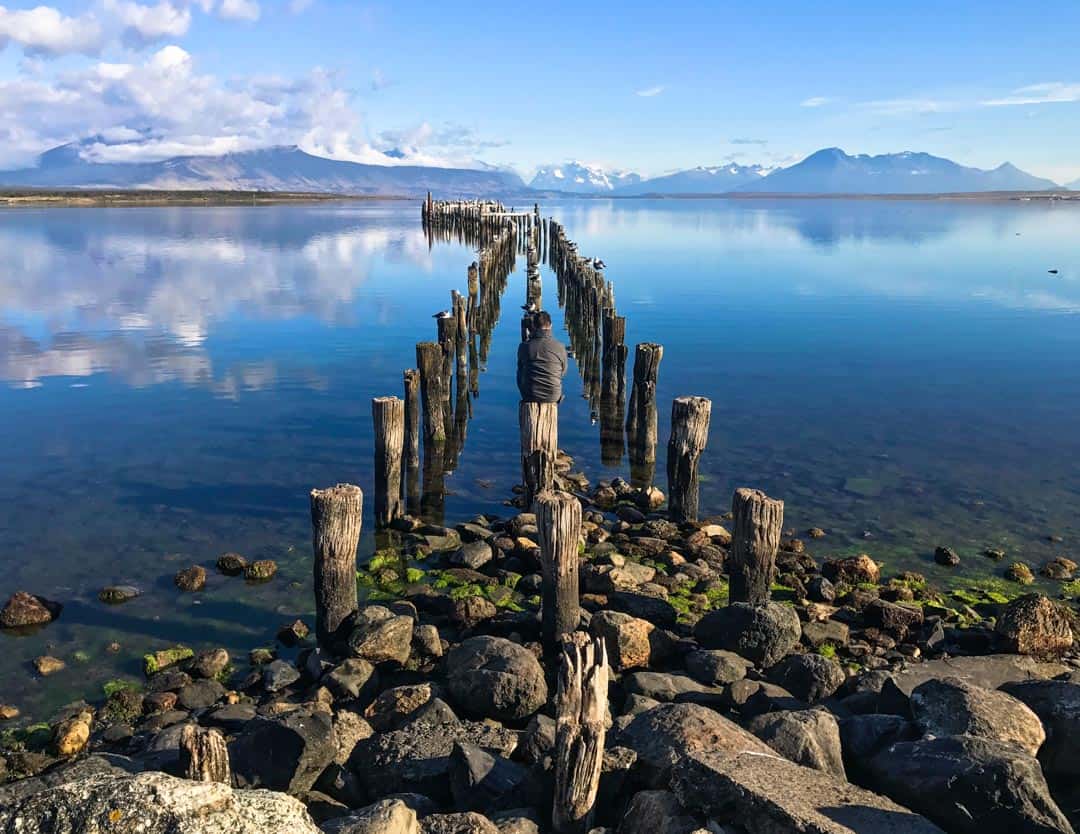
Accommodation in Puerto Natales
Puerto Natales isn’t a big place, but you’ll find plenty of budget hostels and mid-range stays, as well as some beautiful luxury accommodations in and around the town.
We stayed at the charming, centrally-located Hotel Aquaterra both before and after our trek. This is a great mid-range option and we really enjoyed our time here. They also stored our luggage for us while we were on the trail.
Here are some other highly rated suggestions, all of them centrally located and all including breakfast:
Good value: Hostal America en Puerto Natales – Clean and comfortable hostel with friendly staff, and close to bus station.
Mid-range: Hostal Boutique Factoria Patagonia – A modern, upmarket hostel with very clean, comfy rooms and helpful staff.
Spend a bit more: Vinnhaus – Beautiful, stylish and welcoming boutique hotel in the centre of town.
For more accommodation options like this in Puerto Natales, take a look at Booking.com. Or, if you’re after something more in the budget range, you’ll find various hostel options here.
Entry to Torres del Paine National Park
Entry to Torres del Paine National Park is ticketed and there are capacity limits in the mountain lodges and campgrounds. This is for the long-term care and protection of this wild and remote place, and for the safety of visitors to the park. So whether you’re planning to hike the W, trek the O circuit or visit for the day, you will need a ticket to get into the park.
You must buy your entrance ticket for Torres del Paine National Park in advance of your visit to the park. Visit Chile’s official National Park Passes website to buy your park entry ticket.
Entry fees vary depending on whether you are Chilean or international, as well as your age, and whether you intend to stay in the park up to, or more than, three days. At last check, during high season, international adults 18 and over will pay CLP$32,400 (CLP is Chilean pesos) for up to three days in the park, and CLP$46,200 for more than three days.
Download your ticket to your phone before you head to the park (there’s very limited internet access once you’re there) and carry a printed copy just in case. Bring ID as well to present along with your ticket when you check in at the park.
Booking Camping and Accommodation on the W Trail
There are various ways to stay overnight on the W trek in Torres del Paine National Park, but whether you’re planning a lodge stay, hiring camping equipment, or camping with all your own gear, you’ll need advance reservations to do so.
Overnight reservations are mandatory for Torres del Paine and, like park entry tickets, need to be made in advance. You cannot book camping or accommodation once you’re at the park, or camp outside the designated bookable camping zones.
You’ll also need to carry evidence of your overnight reservations as you may be asked to show proof at any time by a park ranger or when passing through checkpoints. We printed our reservation confirmations and carried these with us.
With Torres del Paine trekking becoming ever more popular, limited accommodation spots and advance booking necessary, sorting out campsites or lodge accommodation is – in our experience – probably the trickiest part of planning a self guided W trek itinerary.
For this reason, we recommend booking your overnight stays as far in advance as possible, preferably as soon as bookings open for the season.
It also pays to be flexible about where you stay, as you may find you need to rework your trekking dates and approach based on what’s available.
Our final W trail hiking itinerary was the direct result of where and when we could get an overnight booking.
How to book your overnight stays in the park
There are a number of mountain lodges (refuges) and campsites in Torres del Paine, and you can only stay overnight in these designated zones.
Broadly speaking, the zones in the east are managed by Las Torres Patagonia (formerly Fantástico Sur) and those in the west are managed by Vertice Travel.
There also used to be a couple of free campgrounds in the park managed by the Chilean park agency, CONAF. However, these campgrounds have been closed for several years now.
You can book campsites and refugio beds direct via the Las Torres Patagonia and Vertice Travel websites, however we know from experience that trying to align availability and book spots for a workable W circuit itinerary across different websites can be complicated and time-consuming. Another reason to plan well ahead.
We’re also aware of a website called Booking Patagonia, which offers an integrated booking system for travel, tickets and accommodation for Torres del Paine.
If you’re keen to go self-guided on the W, but you’d like to have someone else sort out the logistics of your trek, including transport, accommodation, meals and camping gear, check out these two great options offered by Flashpacker Connect: 5-day W Trek self-guided camping trip and this 5-day W Trek self-guided refugios (lodges) trip.
Alternatively, you could join an expert mountain guide and small group for a guided 5-day W Trek with the Flashpacker Connect crew, winding up your amazing adventure with a walk on Grey Glacier.
Bus tickets to and from Torres del Paine National Park
We based ourselves in Puerto Natales, the nearest town to Torres del Paine, before and after our trek and most travellers do the same. From Puerto Natales, it’s an easy bus trip to and from the park.
If you’re travelling by bus, we recommend organising your bus tickets to and from Torres del Paine well in advance. Don’t leave this until the day you head to the park or you may find the buses already full.
If you plan to buy your tickets when you arrive in Puerto Natales, aim to do so as soon as you arrive in town. You can buy bus tickets at the main bus station (Terminal Rodoviario), or through your hotel or hostel. We travelled to Puerto Natales by bus so we bought our tickets to Torres del Paine at the bus station the day we arrived. You can also search bus services and buy tickets online here.
It’s important to note that your bus drop-off/pick-up points at the park may vary depending on your final W trail itinerary, so keep this in mind when booking your bus ticket.
If you follow this itinerary and trek from east to west, you’ll start with the bus from Puerto Natales to Laguna Armaga. After your trek, you will board the bus at Pudeto for the return journey to Puerto Natales (this follows a catamaran ride across Lake Pehoe to Pudeto from Paine Grande). Vice versa if you’re hiking the W from west to east.
To ensure you’re on the trail in good time (and in line with this itinerary), we recommend booking one of the earliest buses out of Puerto Natales on Day 1.
Packing for the W Trek
Any hike, but especially a multi-day hike, can quickly lose its appeal if you’re carrying too much weight in your pack; something we can personally attest to. So we strongly recommend packing light and only carrying the clothes, gear and food you need for the trek.
If you’re travelling longer term and have more stuff with you – which was our situation – leave it in storage at your hotel. Your back will thank you for it.
Between us, we hiked with a large, 60L top-loader pack (which we hired in Puerto Natales) and a 27L daypack. This was more than enough for the two of us to carry what we needed for the five day hike.
You can find most of what you need to buy or rent in Puerto Natales for hiking into the surrounding landscapes, from tents, sleeping bags, camping stoves and hiking poles to dried fruit and nuts for your trail mix.
That said, this is a small and relatively remote town and the local prices reflect it. We’re told there’s more choice and better prices at the supermarkets and shops in Punta Arenas, so if you’re coming from or via Punta Arenas, you might consider doing your trek shopping while in that town.
We’ve also read reports that it hasn’t been so easy to find dehydrated meals in Puerto Natales. If you’re planning your menu around these, you might think about sourcing them elsewhere.
It’s important to know that Chile has stringent rules around what foods you can and can’t bring into the country (fresh foods, fruits, honey, etc are a no-no). Be sure to declare any foodstuffs you do bring in and plan on buying most of what you need for trek meals and snacks once you’re in the country.
We had a tight meal plan for our spin on the W, but with hindsight, we would swap out some of the bulkier food stuffs we packed for lighter, more compact foods. Next visit, we’ll be looking to pack some dehydrated camping meals and light-weight but filling carbs like cous cous and oats.
The night before the trek, organise any food you’re carrying into daily packages of brekkie, lunch and dinner. Pre-bundling your meals saves scrabbling around in your pack for particular items on the trail). Then pack all the gear you’ll be taking with you in waterproof bags inside your backpack.
Cash, pesos or credit card?
One question we get asked is whether to carry US dollars or Chilean pesos into the park, and whether the refuges accept credit cards.
We carried all three. We paid for some things in pesos, like snacks and the shuttle to the trail head, and other things in USD, like the catamaran from Paine Grande to Pudeto. We also used our credit card at one of the refuges to buy drinks. It’s our understanding that all of the refuges accept credit cards.
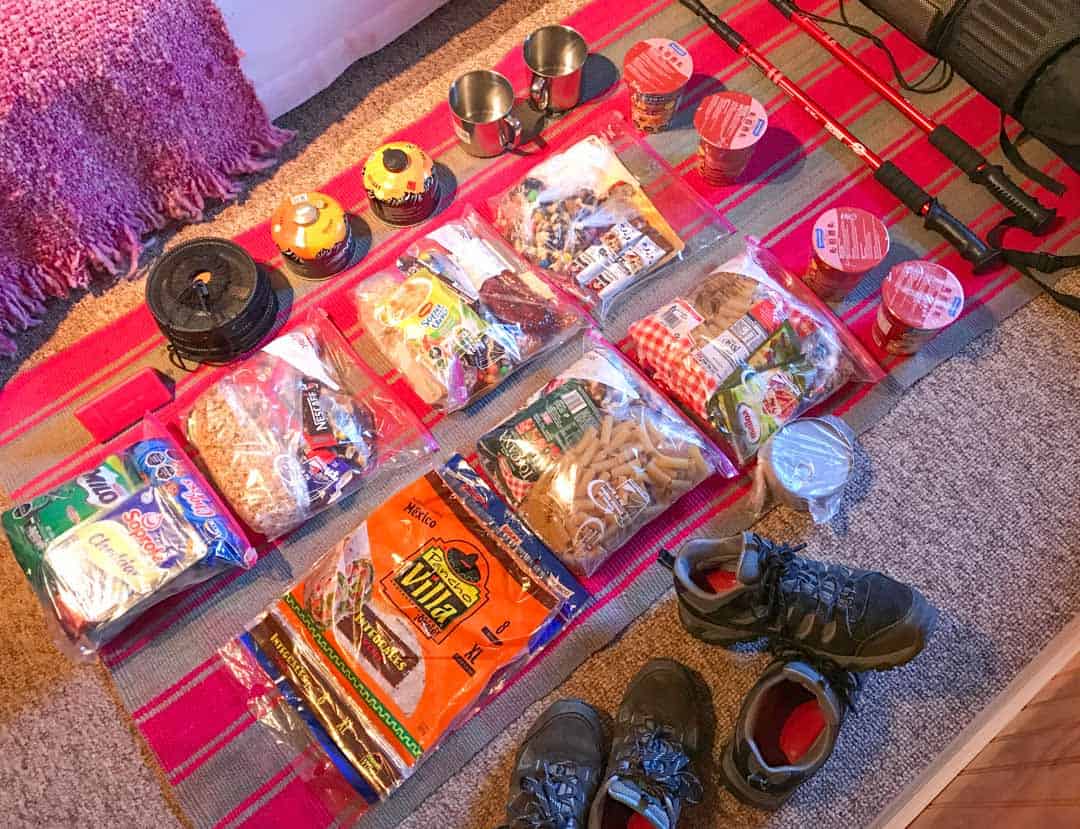
Our self-guided itinerary for hiking the W Trail
Day 1 – Puerto Natales to Chileno via Las Torres
Total distance: appx. 13.8 km (8.5 miles)
Total time: appx. 8 hours
Overnight: Camping Chileno
Let’s get trekking! Hopefully you’ve secured your seat on one of the earliest buses out of Puerto Natales this morning (see above regarding buying your bus tickets in advance).
Buses making the run to Torres del Paine National Park generally depart from Terminal Rodoviario in town. Find your bus and load your pack, then kick back until it’s time to go. It’s around two hours to Laguna Amarga, the gateway to Torres del Paine National Park, so settle in, this is a perfect excuse to grab some extra sleep before starting the hike.
When you arrive at the Laguna Amarga Ranger Station, have your pre-purchased park entry ticket ready on your mobile phone or bring a printout. Here, you’ll check in and receive information about visiting the park, and its rules and regulations.
Don’t forget to buy your entrance ticket for Torres del Paine before you head to the park. Head to Chile’s official National Park Passes website for more information.
At Laguna Amarga, hikers split into two groups: those starting their journey here at the eastern end of the park, and those heading to the western starting point at Paine Grande, which involves a further bus trip to Pudeto and a catamaran ride across Lake Pehoé (even if you’re hiking west to east, you’ll get off the bus here to check in before reboarding the bus for Pudeto).
If, like us, you’re hiking the W from east to west, your next step after check in is to jump aboard the Hotel Las Torres public shuttle bus from Laguna Amarga to the Welcome Centre and the eastern starting point of the trek. This costs around US$5 per person and is paid in cash as you board (we paid this in pesos).
Alternatively, you can start your hike here from Laguna Amarga. The shuttle will just spare you a dusty seven kilometre walk along the gravel road.
There’s a toilet at Laguna Amarga, and another at the Welcome Centre. This is a good chance to go before setting off into the mountains.
Trekking tip: We booked our first night’s accommodation at Camping Chileno, which is en route to today’s main destination – the towering granite peaks of Las Torres. We’ll be checking in at Chileno on the way and dropping off our packs ahead of the steep and challenging climb to the Las Torres mirador.
If, however, you’ve booked your first night at Hotel Las Torres or Central Refuge and Camping, then we’d suggest dropping off your packs there first, and setting out on today’s hike to Las Torres with a lighter load.
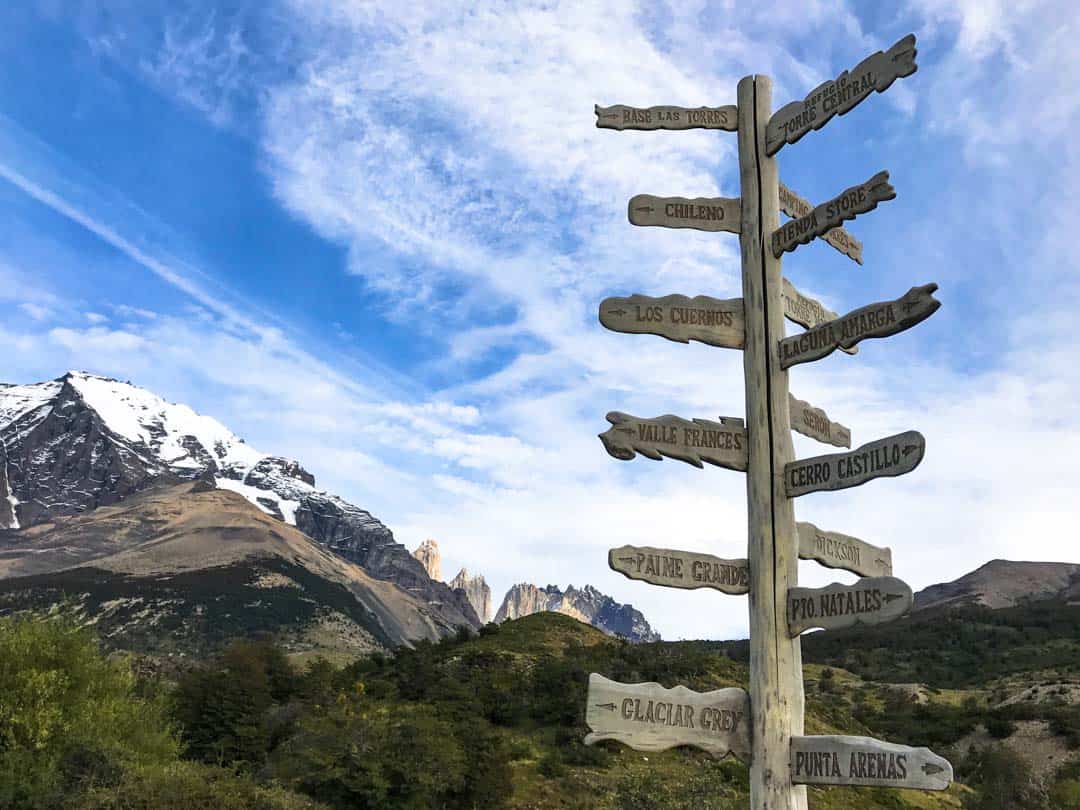
1st Leg: Hotel Las Torres to Chileno
(appx. 5 km / 3.1 miles, around 2 hours)
We’re officially underway on the W trail around 10.30am and from the word go, the views are eye-popping. After a flat kilometre or so, the path starts to climb: get used to it, it’s pretty much uphill from here.
The hike is moderately steep in some spots, until about a kilometre (0.6 miles) or so from Camping Chileno, where the trail flattens out a little before descending into the campground.
Despite feeling like our hearts might explode for much of this first stretch, we cover the distance in around two muscle-busting hours, with frequent stops to take in the views, rehydrate, and give our racing pulses a break.
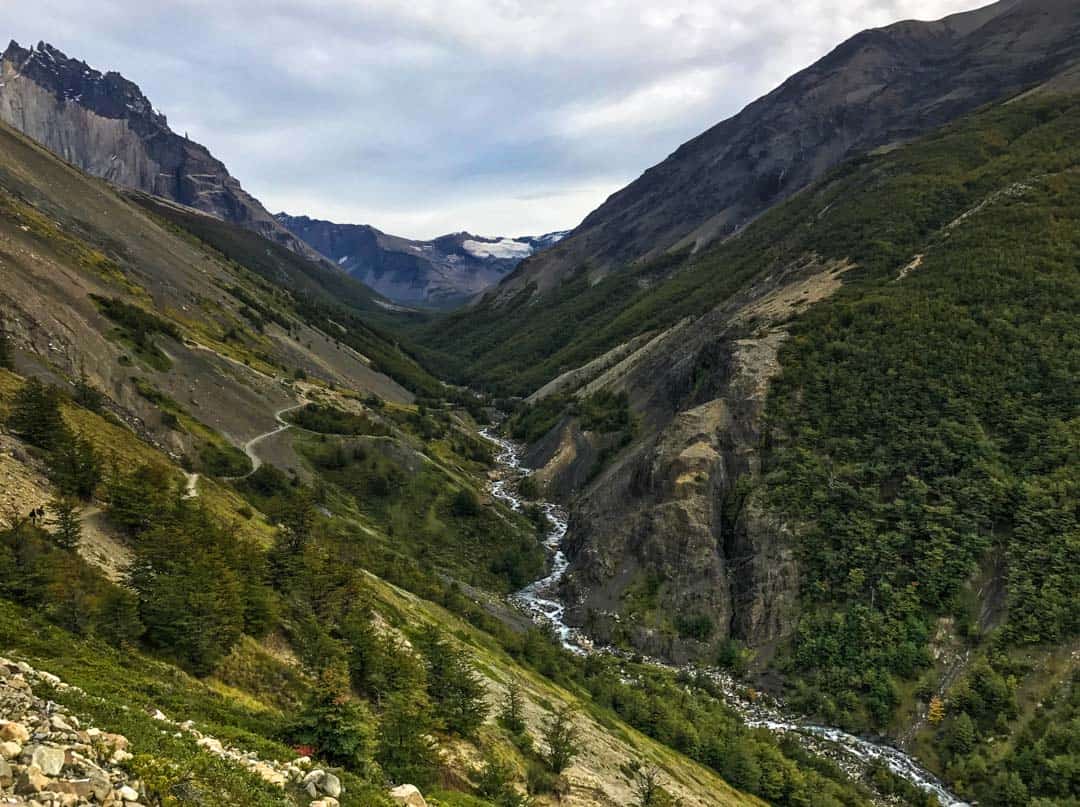
Drinking water
There’s no need to lug extra water with you on the Torres del Paine circuit. You’ll pass pristine mountain streams regularly throughout your journey.
Bring a water bottle, fill up at nature’s tap and enjoy some of the purest water you’ll ever drink. Just remember to top up well away from the camps and upstream of the trails.
We haul into Chileno around 12.30pm. This campground is operated by Las Torres Patagonia (formerly Fantástico Sur), and is the closest camp you can stay at to the famous Las Torres hike and mirador (the CONAF-managed campground near the base of the Las Torres climb has been closed for some time).
The riverside setting at Chileno is truly stunning and the sheer peaks of the three granite towers – our ultimate goal today – rise tantalisingly above the forested mountains ahead.
The campground itself is a nice set-up of tiered camping platforms among the trees. There are shared bathrooms with hot showers, and a restaurant and bar with big windows, plus an outdoor terrace for soaking up the epic views.
Our tent is ready for us when we arrive at Chileno, so we check in, drop our big pack in our tent, pack the daypack with valuables, snacks, water bottles and cameras, eat the lunch we prepared last night, and set out for Las Torres around 1.30pm. Timings here may vary depending on your check-in.
2nd Leg: Chileno to Las Torres
(appx. 4.4 km / 2.7 miles, around 2 hours)
This is without doubt today’s toughest leg, so there’s a huge bonus in not having to tote your full pack up the mountain.
From Chileno, you’ll hike for around 3 kilometres (1.9 miles) or so along a meandering path through pretty woodland, across rushing rivers, and through a wonderfully moody stretch of fallen forest that we dub the ‘tree cemetery’. It’s a lovely, moderate walk, and we have no sense of what’s ahead when we reach the sign that tells us ’45 minutes to Mirador Las Torres’.
My notes from this point in our trek simply state: ‘hiking hell starteth here’. A touch dramatic maybe, but as irregular hikers, this was probably the hardest section of the entire W for us. Maybe you’ll breeze through it, just be ready for it.
Shortly after the sign, the climb to Las Torres begins in earnest. It’s a gritty, rocky terrain of steep, gravelly inclines and large boulders. The panoramas as you climb are absolutely breathtaking, but so is the hike itself. There are moments while we’re in the throes of it, looking up and spotting the tiny trekkers far above, that this stretch feels like it will never end.
It does end though, about an hour later, and the scene that awaits as we round a final boulder and face the towering granite pillars of Las Torres makes every single breath-wrenching step worth it.
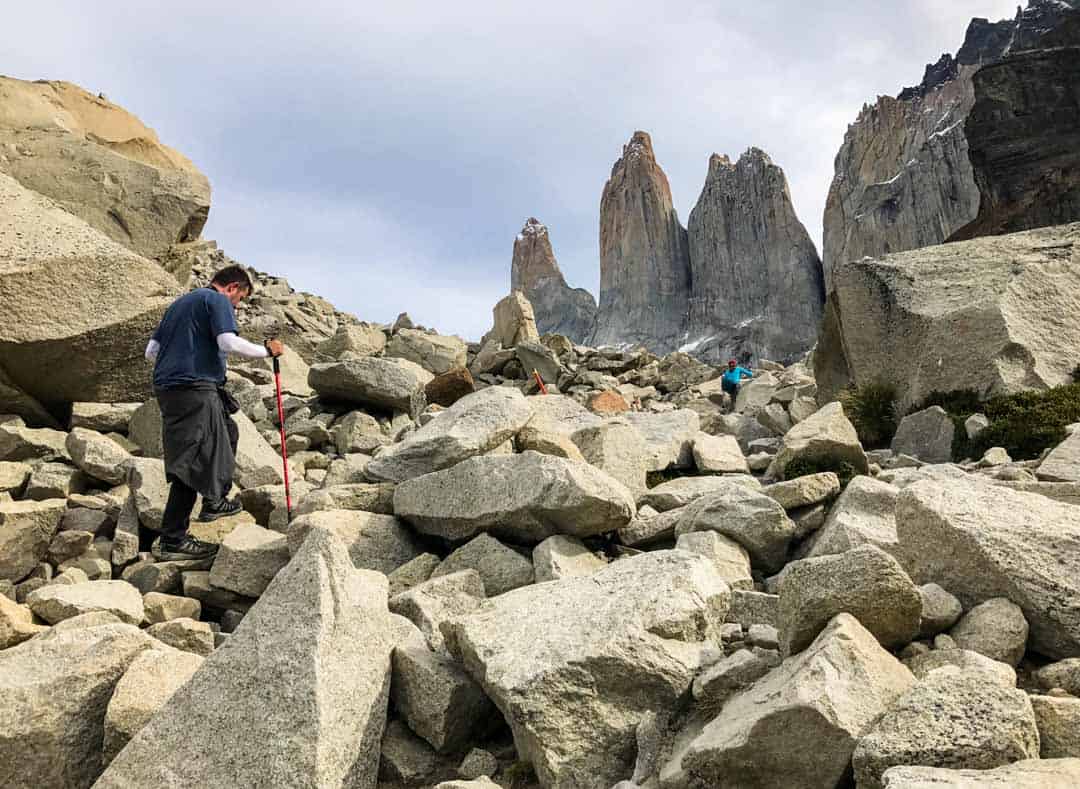
It’s buzzing at the top: hikers drape the rocks surrounding the glacier lake; a bushy-tailed Patagonian fox weaves its way between the boulders; there’s even a guy getting his hair cut at the water’s edge (one hairdresser’s quirky approach to memorialising his travels while promoting his business).
We spend some time taking pics before settling onto a boulder of our own to simply take in this awe-inspiring scene. Aim to spend around an hour at Las Torres.
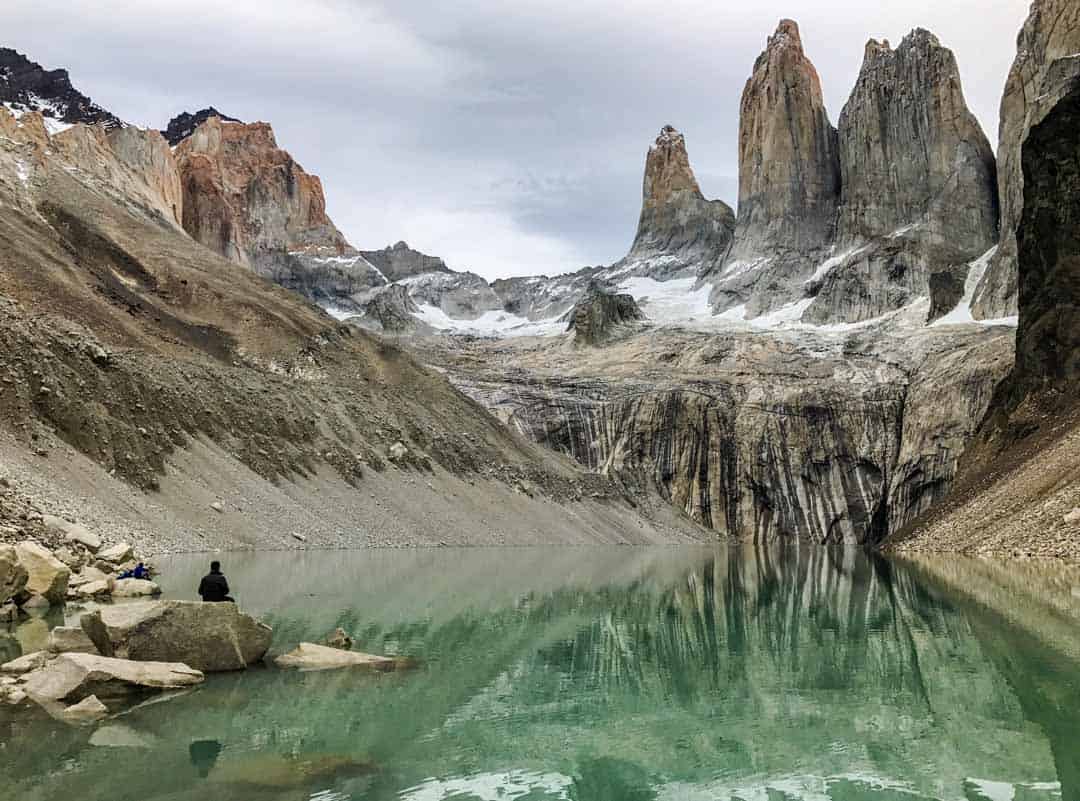
3rd Leg: Las Torres to Chileno
(appx. 4.4 km /2.7 miles, around 2 hours)
The journey back down from Las Torres is in some respects even more challenging than the climb up. The constant down is tough on knees and the gravel makes the going slippery. We’re beyond grateful for our hiking poles, though we both still manage to pull off some memorable butt slides.
Trekking tip: Hiking poles made all the difference for us when we were trekking in Patagonia. We carried one each, which was ideal as it left us both with a hand free to grab branches and rocks, haul each other up and down, and catch our fall when we slipped. Which was often.
It takes us around two hours to get back to Chileno; we have time to shower, buy a couple of well-earned beers and watch the sunset burn the tips of Las Torres molten gold.
It was cloudy the entire time we were up at the base of the towers, so watching them all beautifully backlit now is a bit of a kicker, but if there’s one thing you’ll learn quickly hiking the W Patagonia, it’s that the weather doesn’t give a rats what you think.
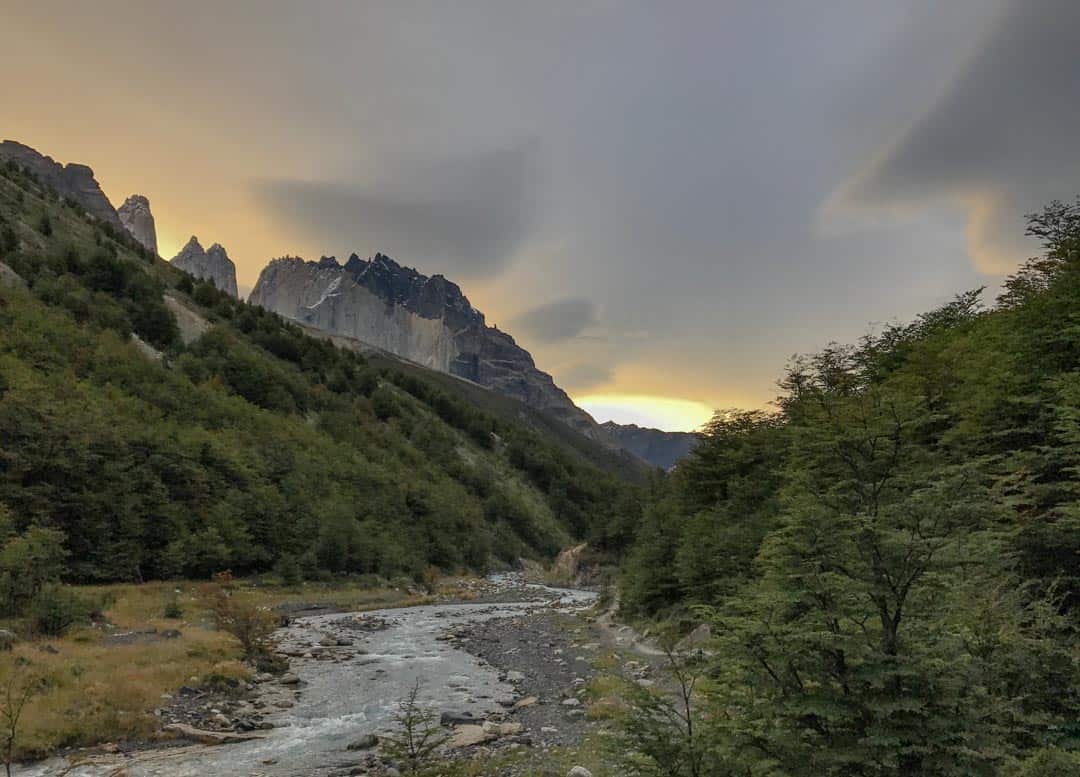
Preparing for Patagonian weather
If there’s one constant about the weather in Patagonia, it’s that there’s nothing constant about it.
We were particularly lucky on our five days in Torres del Paine, but you should be ready for four seasons in a day. Layer up, have a rain jacket handy, and wear quick-dry clothes.
Skip a rain cover for your bag though. While we never experienced the legendary winds that tear through the park from time to time, we heard plenty of stories of pack covers being whipped off suddenly and disappearing into the wilds.
Expect to get rained on, and pack your gear in bag liners or waterproof bags inside your backpack instead.
Cooking stoves are not allowed to be used in the Chileno zone, so we opted for the full board food package here, which includes dinner tonight, breakfast tomorrow and a packed lunch to take with us.
Later in the evening, we join a host of other hikers in the restaurant for a surprisingly tasty and filling three-course meal full of protein and carbs.
We’re absolutely wrecked by the end of dinner, and we’re tucked up in our sleeping bags by 9.30pm.
Sunrise at Las Torres
When we originally planned our itinerary for hiking the W, we had every intention of doing a second trek to Las Torres for sunrise on Day 2. In late March, this would have entailed getting back on the track up the mountain by 5.30am.
As we climbed into our sleeping bags that first night though, we decided to pull the pin: we were just too tired, and we were also a little wary of making the tricky climb in the low dawn light.*
It was a tough call at the time, and it didn’t help when we poked our heads out of our tent the next morning to see the stone towers erupting with golden light above the silhouetted foreground. As we watched though, the clouds rolled in and soon enough the peaks were shrouded in mist.
There’s no accounting for Patagonian weather, or how your body may feel after a long day of hiking. The best you can do is plan, and be flexible on the day.
*PS. For safety reasons, hiking in the dark isn’t actually allowed in Torres del Paine. Trail sections have opening and closing times, which can be found in the information brochure you’ll receive at the park.
Day 2 – Chileno to Francés
Total distance: appx. 18 km / 11.2 miles
Total time: appx. 6 hours 45 minutes
Overnight: Camping Francés
Sunrise is around 8am when we do the W trek in late March, and as we haven’t made the dawn hike to Las Torres, we enjoy a more leisurely start to the morning on Day 2.
If you do decide to do the dawn hike up to Las Torres for sunrise, factor in around five hours this morning and adjust the following timings for today’s next legs accordingly.
As breakfast is part of our full board package at Camping Chileno, we pack up our gear and head to the dining room at 8.30am for a hearty kickstart to the day.
1st Leg: Chileno to Los Cuernos
(appx. 15 km / 9.3 miles, around 4.5 hours)
We’re on the trail by 9.15am, heading back towards Hotel Las Torres. We won’t be going all the way to the hotel though as there’s a shortcut off to the right around half-an-hour after leaving Chileno. The shortcut is signposted and takes you along a mostly downward sloping path surrounded by undulating hills and lake views.
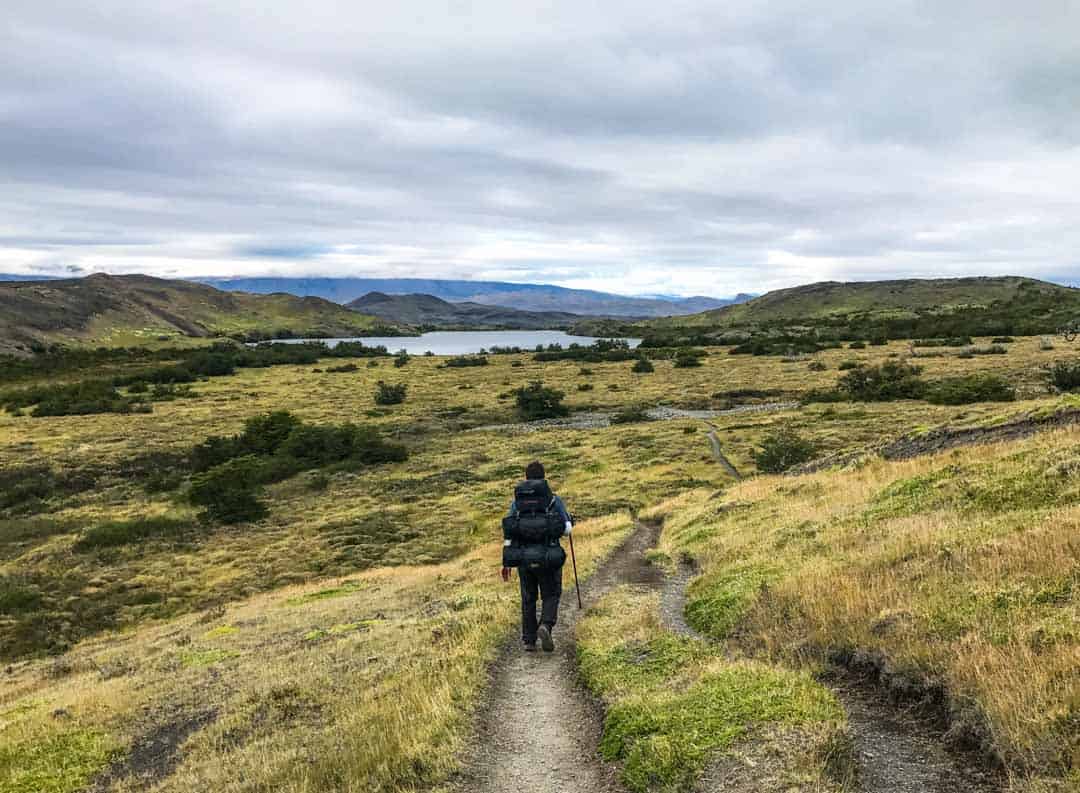
We reach the end of the shortcut and rejoin the main W route around 11am. At some point after this though, we suddenly find ourselves in what can only be described as the Patagonian Swamps of Mordor and we start to wonder whether we’ve veered off on to a secondary trail by mistake.
We can still glimpse the Nordernskjöld Lake off to left, and we know the official trail travels alongside it. To this day, we’re unsure if we did actually go off piste (though the number of bootprints in the mud suggests not).
Eventually, we seem to be back on track according to the map, just a little muddier for the experience (and even more grateful for our depth guage hiking poles).
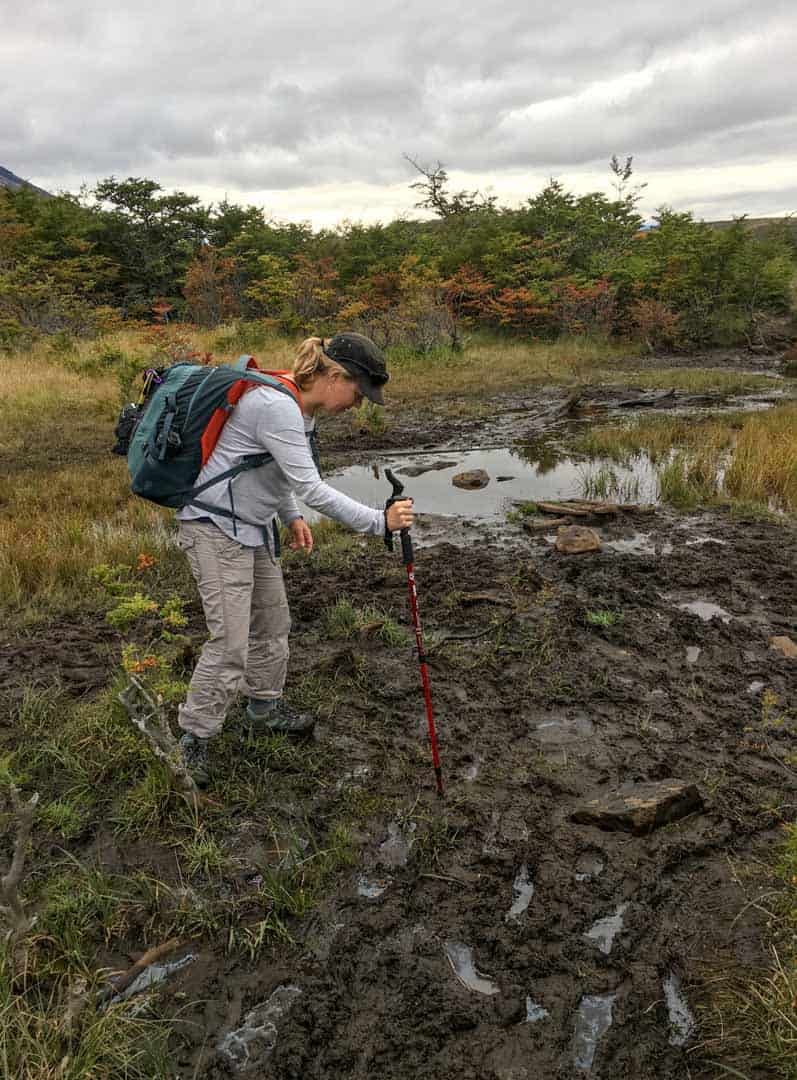
The next stretch travels up and down through very pretty lakeside country, with the occasional steep section, before passing down into the valley at Los Cuernos. We arrive at the Los Cuernos shelter and camping area around 1.45pm.
You could stop at any point along the stretch to Los Cuernos for a lunch break; we stop just past the shelter and find a nice rock with a view. We opted for the full board meal package with Camping Chileno so we’ve been provided with a packed lunch today as part of this.
We chill for around 45 minutes and then set off around 2.30pm for Camping Francés, where we’ll be staying tonight.
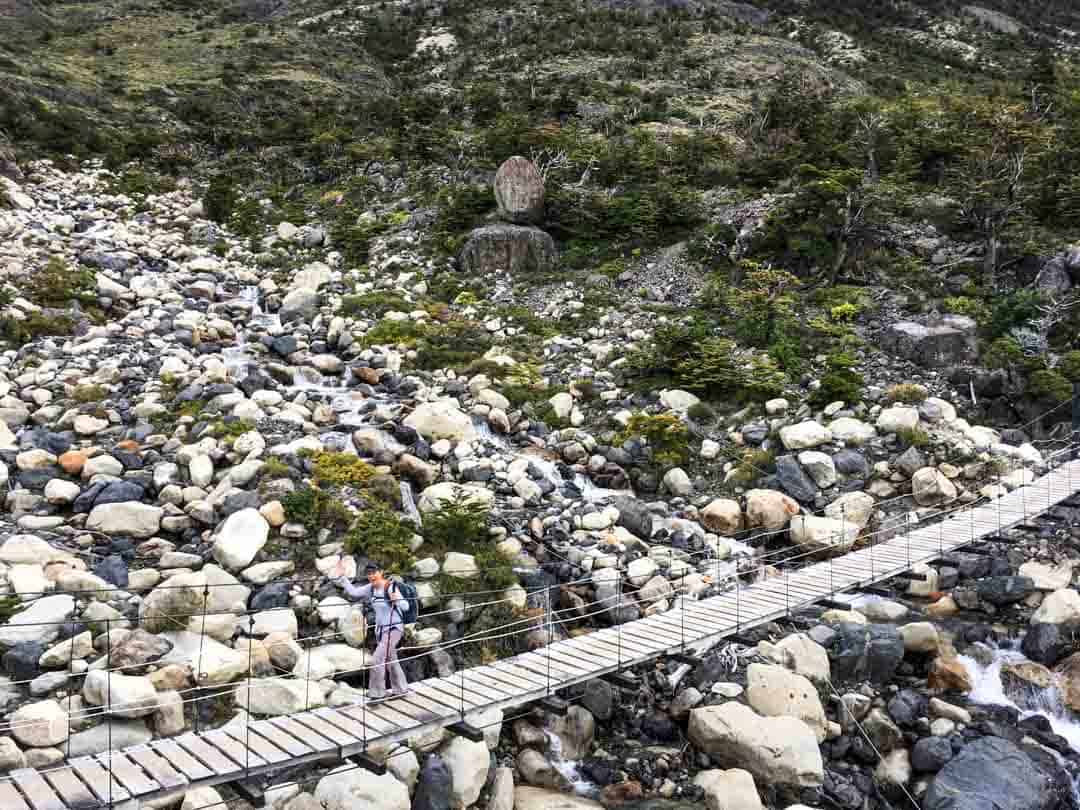
2nd Leg: Los Cuernos to Francés
(appx. 3 km / 1.9 miles, around 1.5 hours)
The trail to the Francés campground is up and down and rubbly, with some steep sections, and a pretty pebbly beach crossing. Today’s walk has been positively sedate compared to yesterday’s heart-starter climbs, but never fear, a leg-burning rise awaits just before the descent into the camp.
We arrive at Camping Francés around 4.00pm. The campground here is run by Las Torres Patagonia (formerly Fantástico Sur).
The tent platforms are clustered between the trees and there’s a good shower and toilet block a short walk from the campsite. There’s also a small shop with basic amenities.
By 5.15pm we’re checked in and set up on our platform. We’ve arranged for a tent at Camping Frances but we’re cooking our own food tonight.
Sunset is close to 8pm in late March, and having made it through our second day on the W trail, we’re zipped up in our sleeping bags soon after.
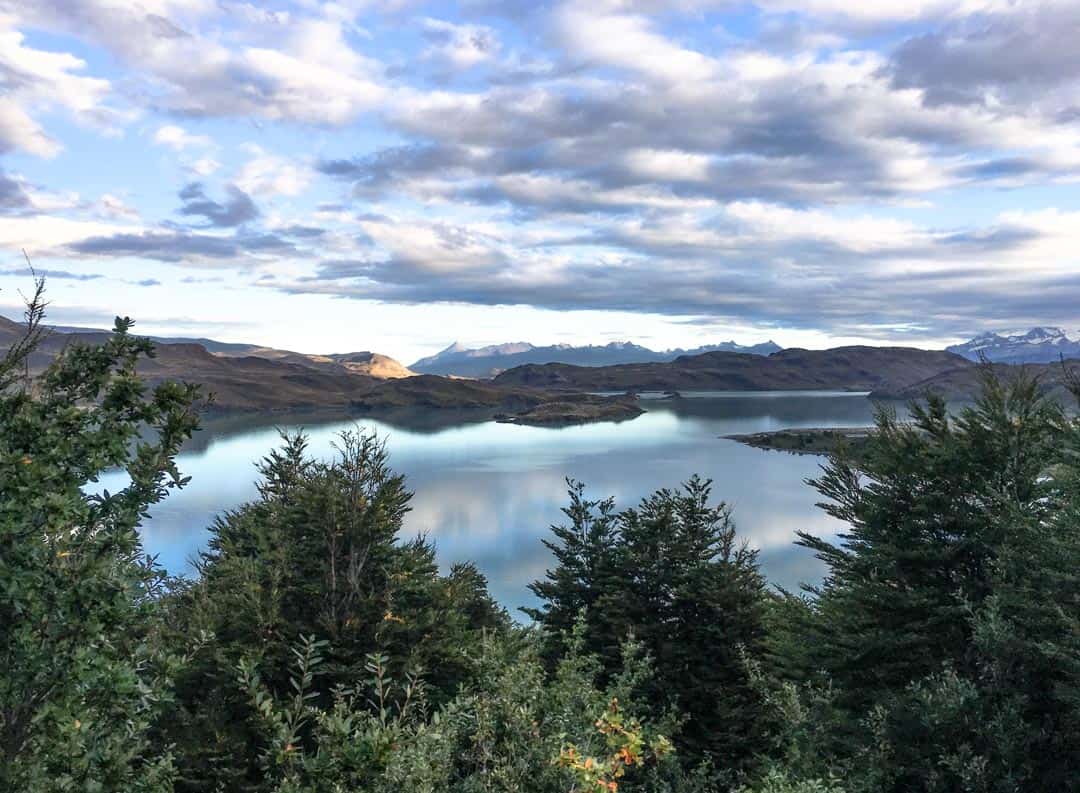
Day 3: Francés to Paine Grande via Francés Valley
Total distance: appx. 20.3 km / 12.6 miles
Total time: appx. 9 hours
Overnight: Camping Paine Grande
Despite our fatigue, neither of us sleeps particularly well on our second night and we’re both groggy when the alarm goes off at 7am.
Our restlessness is partly due to the strange soundtrack that has accompanied us throughout the night: sharp cracking sounds like distant shot gun blasts and deep, thunderous rumbles. It’s not until we set out on the trail through the Francés Valley today though, that the source of the unnerving noises becomes obvious.
On this itinerary, today is the longest day hiking the W, and based on our experience, we recommend getting on the trail by 8am at the latest to maximise your time in the Frances Valley. We departed later when we trekked, so we’ve adjusted the timings below to suit an earlier start.
1st Leg: Francés to Italiano Ranger Station
(appx. 2 km / 1.2 miles, around 30 minutes)
The first leg this morning is a rejuvenating, 30-minute leg-stretcher to Italiano Ranger Station. Aim to pack up and set out from camp by 8am.
There’s a ranger at the Italiano Ranger Station when we arrive. He points to some racks opposite the office building; this is where we opt to leave our big backpack ahead of the challenging hike into Francés Valley.
We sort our valuables and lunch into the smaller daypack, make sure the big pack is locked, and get going again. Look to be back on the trail by 8.45am.
2nd Leg: Italiano Ranger Station to Británico Lookout
(appx. 5.4 km / 3.4 miles, around 3 hours)
The first kilometre (0.6 miles) out of Italiano is a flat trail through pleasant forest, after which the track starts to climb steeply through a rocky, rubbly stretch.
The scenery is seriously beautiful, serving up views of the ironically named Paine Grande Hill – 3,050 metres above sea level – and the Francés glacier that clings to it. This is the source of the crackshots and grumbles we’ve been hearing as the hanging ice shifts, melts and avalanches down the mountain.
Soon enough, you’ll reach the Francés mirador, a lookout offering spectacular panoramas over the ‘hill’ and its glacier; this is the perfect spot for a short break and a snack, as the next stretch is tough.
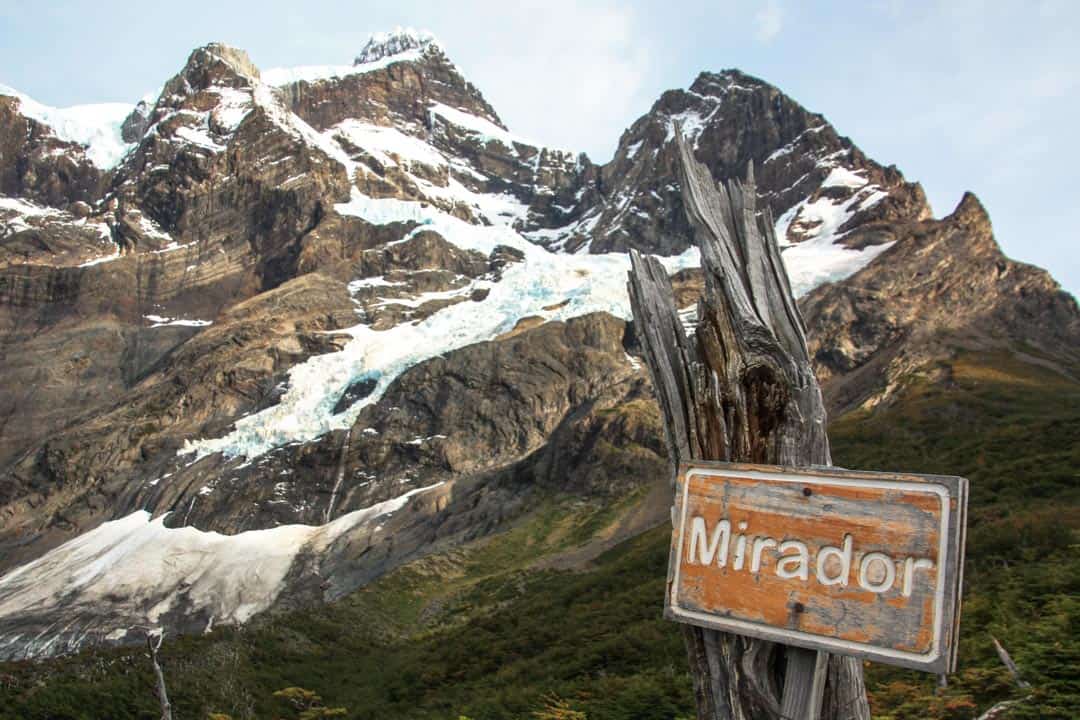
From here, the trail to Británico Lookout is a challenging, rubble-strewn boulder dash with lots of climbing.
A flat, rocky clearance scattered with the parched white trunks of dead trees and overshadowed by the jaw-dropping Cuernos massif, marks the final stretch before a steep, 10-minute climb to the mirador itself.
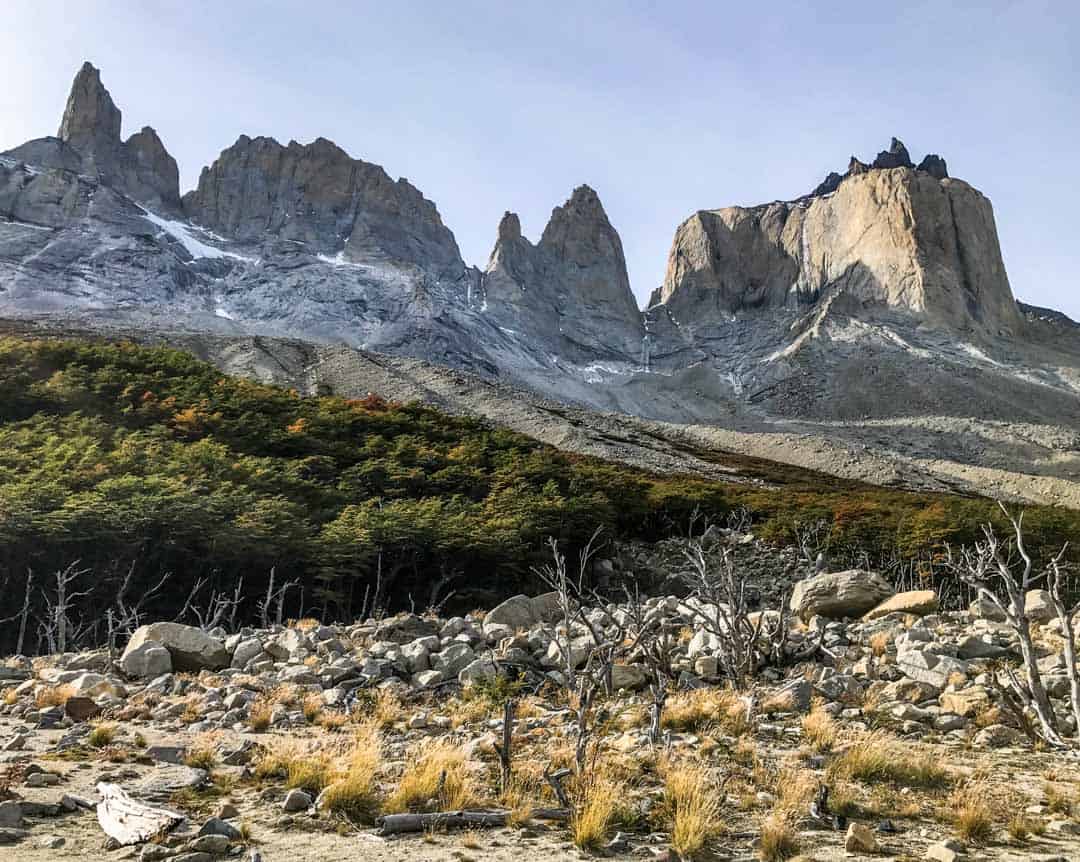
Summitting the boulders of the Británico Lookout around three hours after setting out, we cast our eyes over what will become our favourite panorama of this epic journey: the vast and spectacular Francés Valley. Find a rock to perch on and settle in for lunch with this glorious scene at your feet.
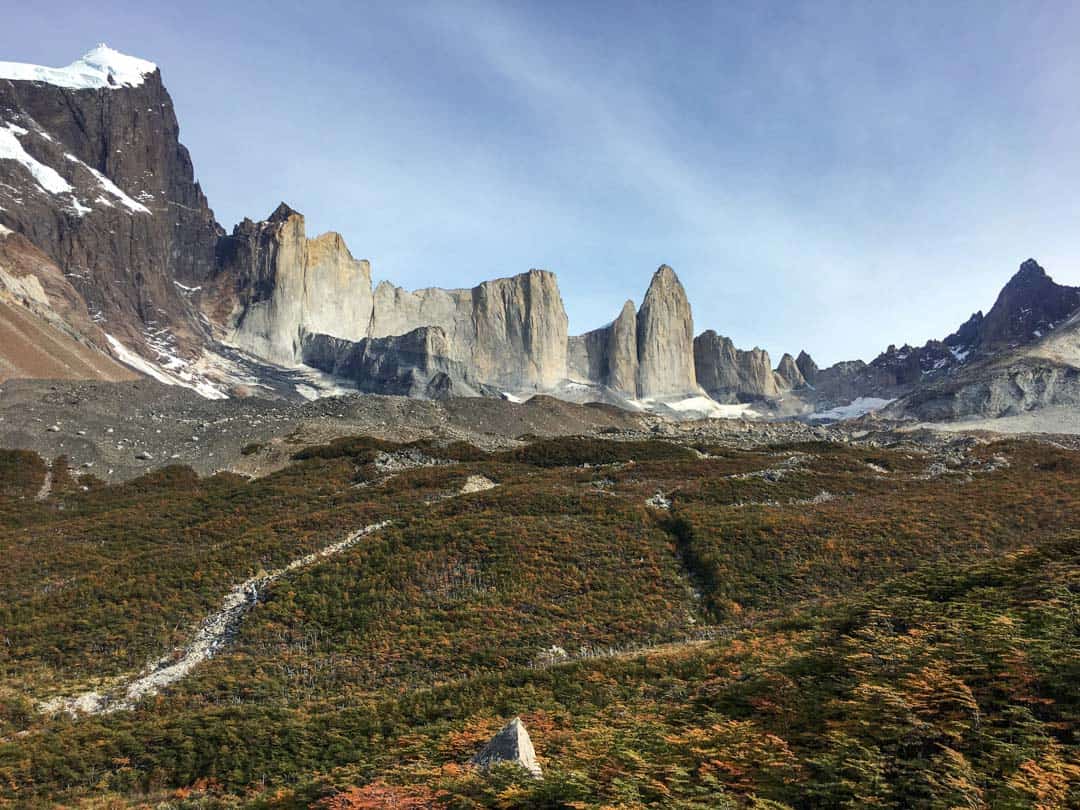
We’ve come a long way, but there’s still a huge day of hiking the W ahead. To our eternal regret, we were only able to linger here for half an hour as we left camp too late on this morning. That’s why we recommend getting on the trail no later than 8am today – trust us, you’ll want as much time at Britanico as possible and by arriving around 11.45am, you’ll have close to an hour here.
We’ve promised ourselves that next time, we’ll spend an extra day or two in this valley so we can take in this view at our leisure. For us, this remains one of the most magnificent vistas we’ve come across in all our world travels.
Trekking tip: Get on the trail by 8am at latest this morning so you can hang out for at least an hour at Britanico, or better yet, stay an extra day in the Francés Valley.
3rd Leg: Británico Lookout to Italiano Ranger Station
(appx. 5.4 km / 3.4 miles, around 2 hours)
Aim to set off back down the trail to Italiano around 12.45pm. We find this a knee-buckling downward journey and our legs are screaming by the time we reach our packs back at the Italiano Ranger Station just over two hours later.
Once we’ve retrieved our big pack (now four-deep in a giant bag pile) and stopped for a quick breather, we set out for the Paine Grande refuge and camping area, starting with a bridge crossing out of Italiano. It’s around 3pm by this stage.
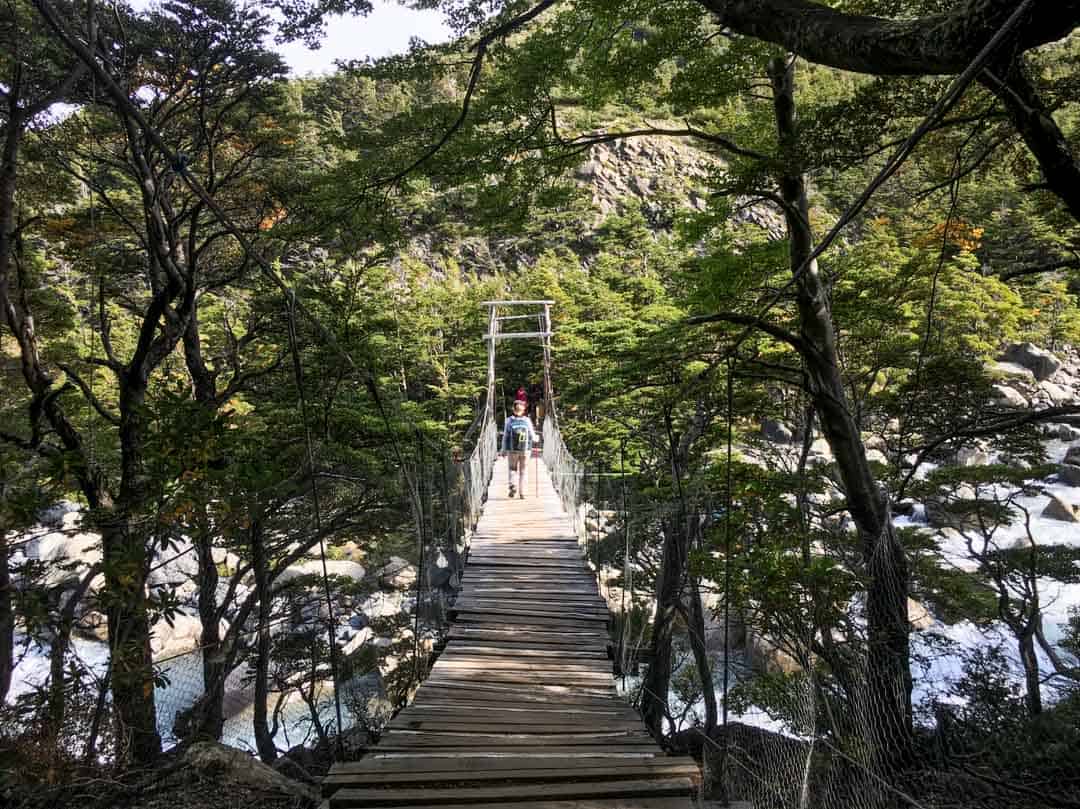
4th Leg: Italiano Ranger Station to Paine Grande
(appx. 7.5 km / 4.6 miles, around 2.5 hours)
The final stretch of the W trail today is a journey of around 7.5 kilometres (4.6 miles) and it’s mostly flat with some sloping ups and downs.
Travelling out of the valley and along the raised walkway as you head towards Sköttsberg Lake, remember to turn around and take in the mountain scene back the other way: it is immense.
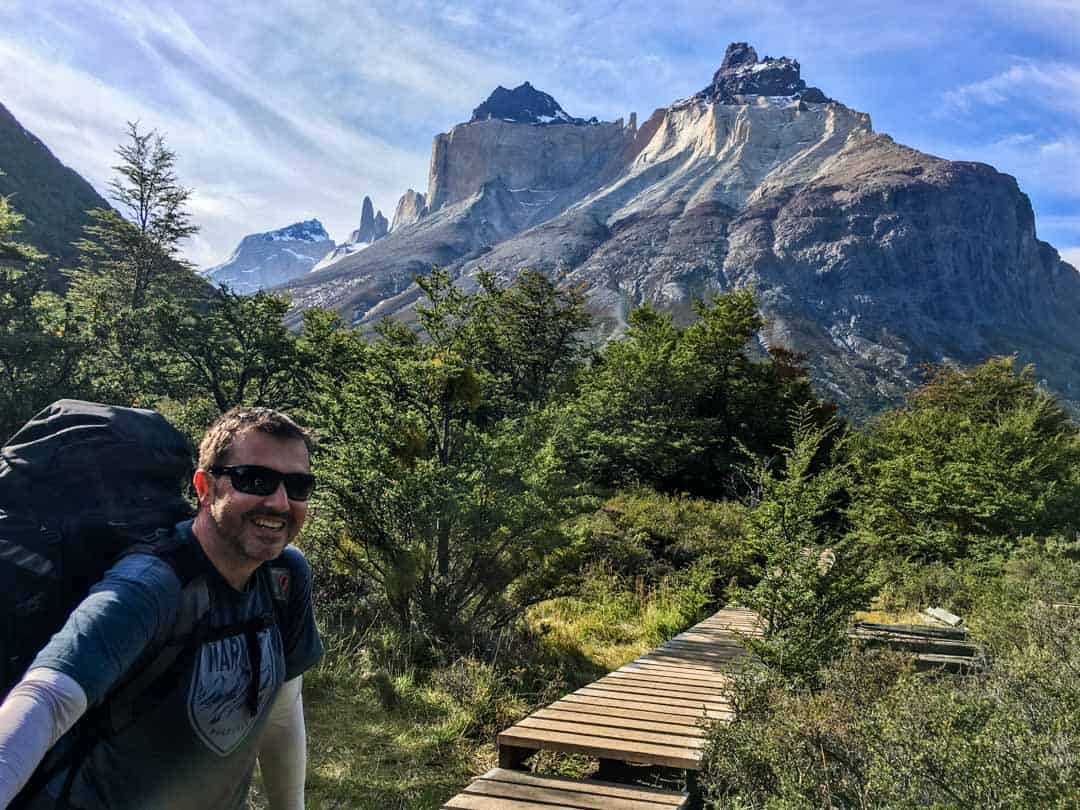
After some more steady rises, we make our final descent into Paine Grande Refuge and Camping around 5.30pm. By this stage, we’re seriously sore and tired and very ready for a beer from the lodge bar, which is the first thing we do once we’ve checked in and sorted out our tent.
The campground at Paine Grande, which is managed by Vertice Travel, is large and separated into sections for campers carrying their own gear, and those like us who have booked a tent. A wooden walkway links the campgrounds with the lodge, the campers’ kitchen and bathrooms.
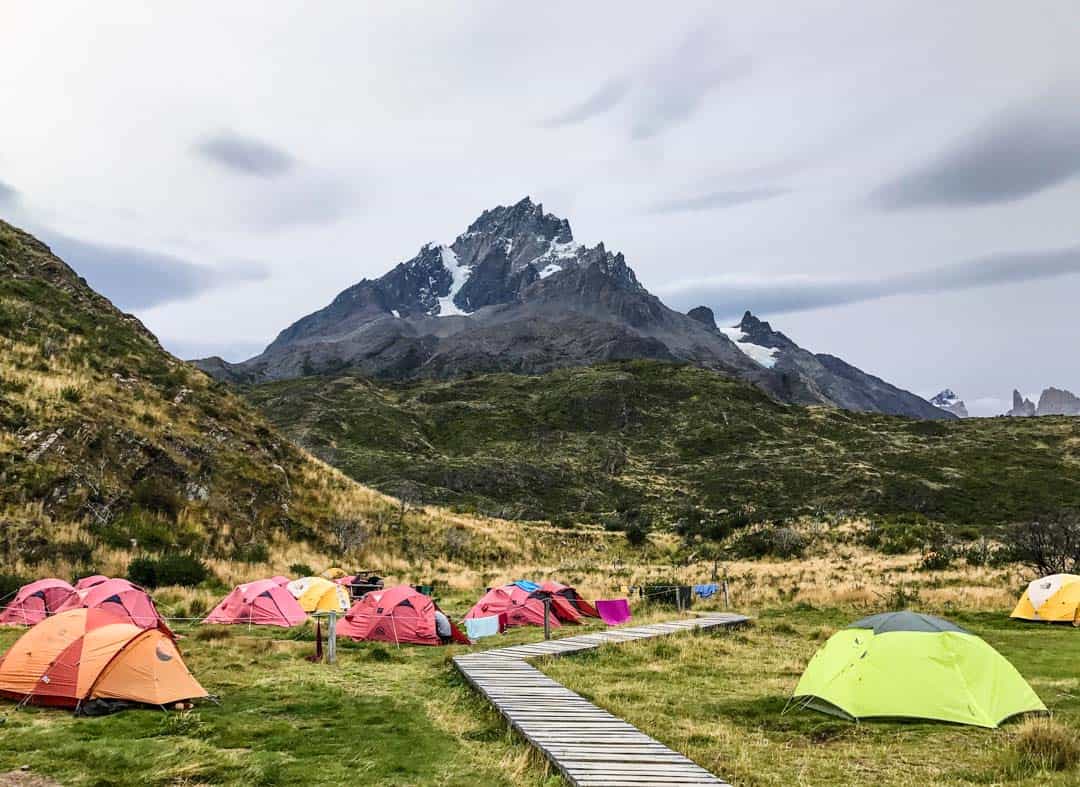
As Paine Grande is the western starting point for hiking the W and a transit point for O circuit trekkers, as well as for day trippers and short stay visitors, this is the largest and busiest lodge and campground in the park.
There’s a good-sized kitchen building, which is heaving with trekkers when we make our way in there to cook dinner around 7pm.
The camp shower and toilet facilities here are basic. We recommend getting your ablutions out of the way while everyone else is cooking dinner and before the post-meal rush. Paine Grande also has dorms, a restaurant and bar, and a mini-market.
We’re tucked up in our tent just as a light rain begins to fall around 8.30pm.
Day 4 – Paine Grande to Grey
Total distance: appx. 11 km / 6.8 miles
Total time: appx. 3 hours 45 minutes
Overnight: Camping Grey
Today is our shortest day so far on the W trail, so we decide to set out a little later as we’re definitely starting to feel the past three days’ hiking, and a strange kind of exhilarated fatigue.
We’re up at 8am with plans to be on the trail by 9am. However the banshee-like screeches of a fox followed by the thrilling appearance of a large, tawny-coloured puma on the hill behind the camp has us – and everyone else – lingering for a while in hushed awe, until the sleek big cat disappears around a bend into the next valley. Which happens to be the same valley we’re about to trek into.
After checking in at the ranger station for advice on what to do if we see the puma again, we set off through the narrow, pretty dell at around 10am. We’re both relieved (and maybe a touch disappointed) to find no further sign of our feline friend.
The big cats of Patagonia
Don’t let the thought of pumas roaming the forests of Torres del Paine put you off trekking there.
The fact is, these magnificent creatures are extremely shy and actively avoid humans. Encountering a puma is incredibly rare. Spotting one near camp as we did is apparently almost unheard of.
However, it’s important to be across what to do and how to act if you do come across a puma. You’ll find advice on this in the guide that you receive when you check in for your Torres del Paine trek.
(If seeing a puma in the Patagonian wilds is on your bucket list though, check out this one-of-a-kind puma tracking day trip out of Puerto Natales.)
The valley walk is flat at first but soon begins to climb, and continues to serve up steady inclines followed by some steep descents into the Grey refuge and camping area.
The scenery on this leg is still epic, but maybe a touch more serene than the high drama mountainscapes of the last couple of days. Grey Lake is flat and still on the day we hike the trail, and dotted with blueish lumps of ice from the vast Grey Glacier at its head.
About halfway along the trail, a rocky lookout reveals the first glimpses of this immense glacier, a sea of ice six kilometres (3.7 miles) wide and 30 metres (98 feet) high in places.
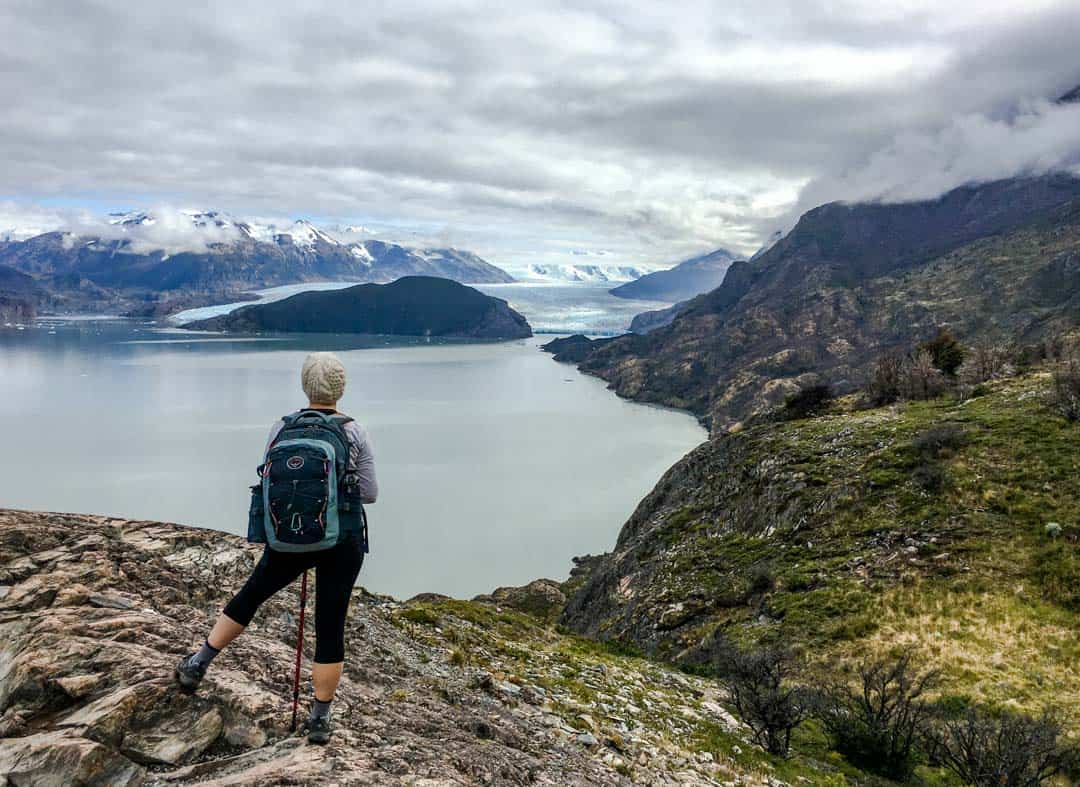
We arrive at the Grey Camping area around 1.45pm, a journey of 3 hours and 45 minutes, with plenty of photo and snack stops along the way.
Grey Refuge and Camping is also operated by Vertice Travel. The lodge has a lovely bar and lounge area in addition to its dorms, and the campground out front is overlooked by the stunning peaks of the Cordon Olguín. By the time we arrive, the clouds have cleared and the mountains burn golden as the sun drops.
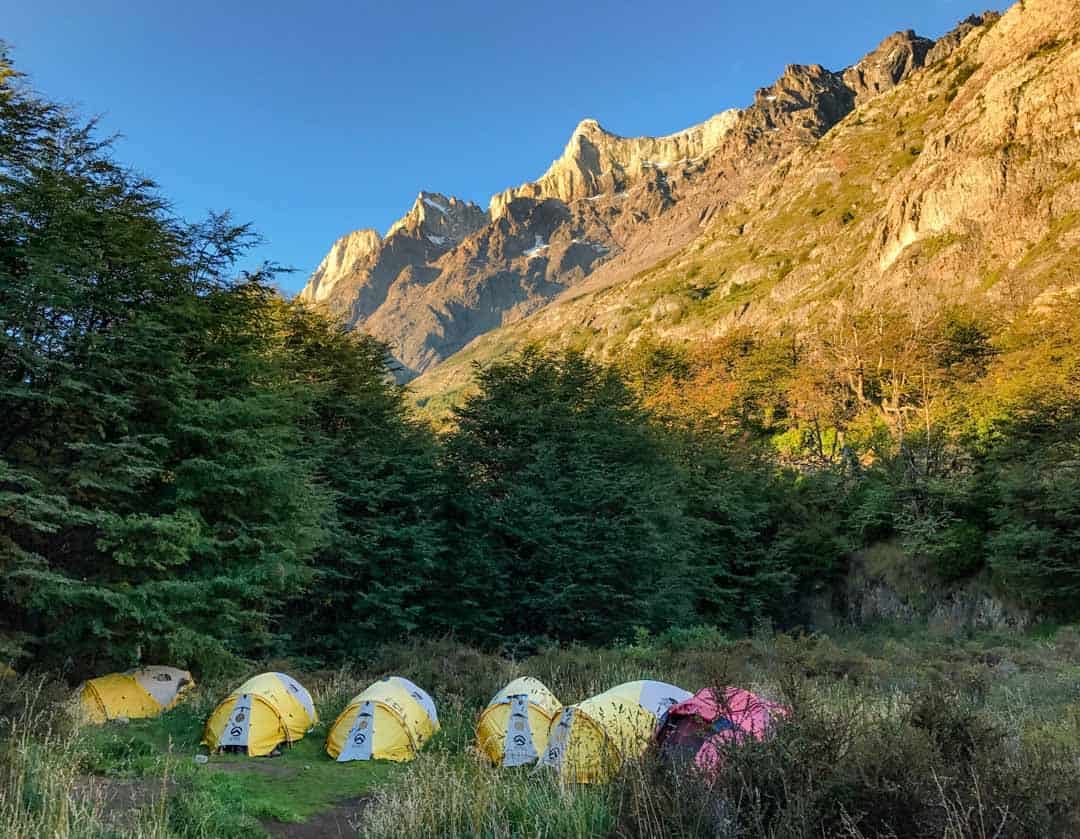
If you’ve got the energy, check in (or leave your pack with the office if check-in hasn’t opened yet), and then head back out to hike past the western tip of the W trail and on to the first leg of the O circuit towards Paso Ranger Station. This will bring you much closer to the glacier, but bear in mind, it’s a five hour, one-way hike to Paso itself.
Trekking tip: Leaving Paine Grande at 10am worked well for us, but if you do want to hike a stretch of the trail from Grey towards Paso and back to Grey today, consider starting out from Paine Grande earlier in the morning so you have more time to do this.
We opt to stop and enjoy our lunch with mountain views, then roll out our mats and nap in the sun until check-in opens.
After getting our tent sorted, we hike to a rocky outcrop on the lake just 15 minutes from camp. The views from here towards the glacier’s terminus are gorgeous and we spend time here just soaking up the scene.
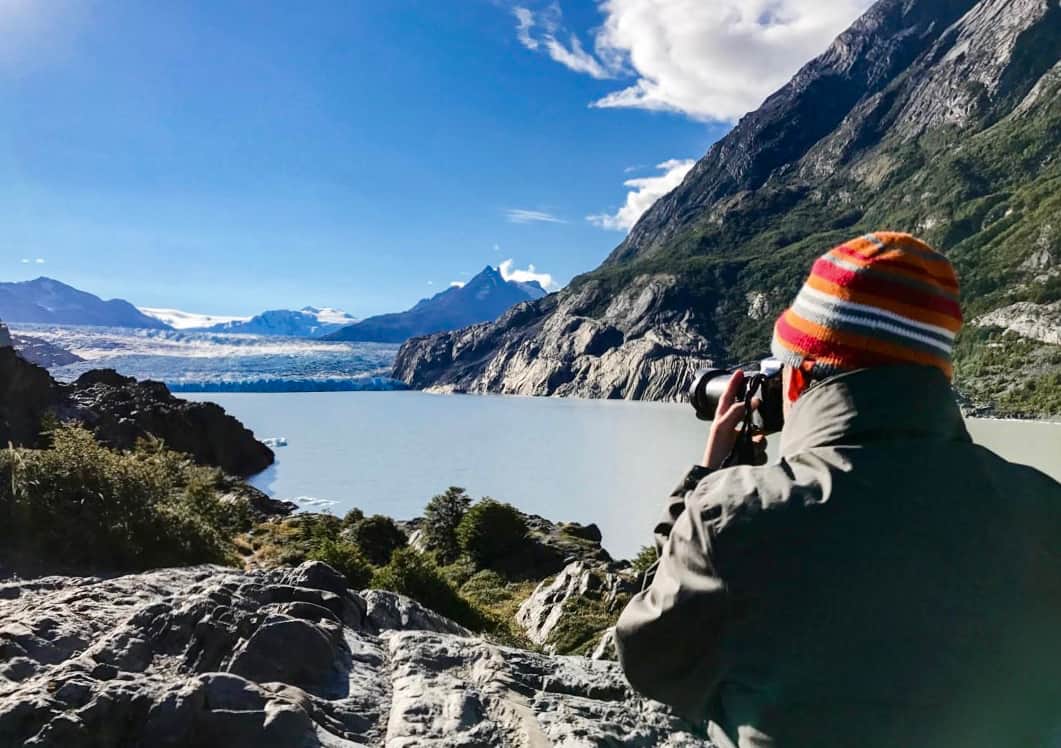
On our return to camp, we head to the lodge for a drink at the bar before making dinner on one of the picnic benches outside the buzzing campers’ cooking area.
In addition to the bar, there’s a restaurant at Grey, and a small shop selling grocery basics. There’s an equally small toilet and shower block for campers (the showers only have certain hours of operation but the water is hot).
We’re in bed by 9pm and prepped for a very early departure in the morning.
Day 5 – Grey to Paine Grande (and return to Puerto Natales)
Total distance: appx. 11 km / 6.8 miles
Total time: 3 hours 15 minutes
It’s our last day on the W hike! We’re on the trail early so we can get back to Paine Grande in time for the late morning catamaran across Lake Pehoe to Pudeto, where we’ll pick up the bus back to Puerto Natales.
It shouldn’t take more than four hours to get back to Paine Grande from the Grey campground, but we’re feeling pretty exhausted by this stage and John has nurtured some nasty blisters, so we’re up and on the trail before sunrise.
It’s freezing when we set out at dawn but as the day lightens, we’re treated to a stunning peach-tinted sky reflecting off the lake, and we stop often to snap pics.
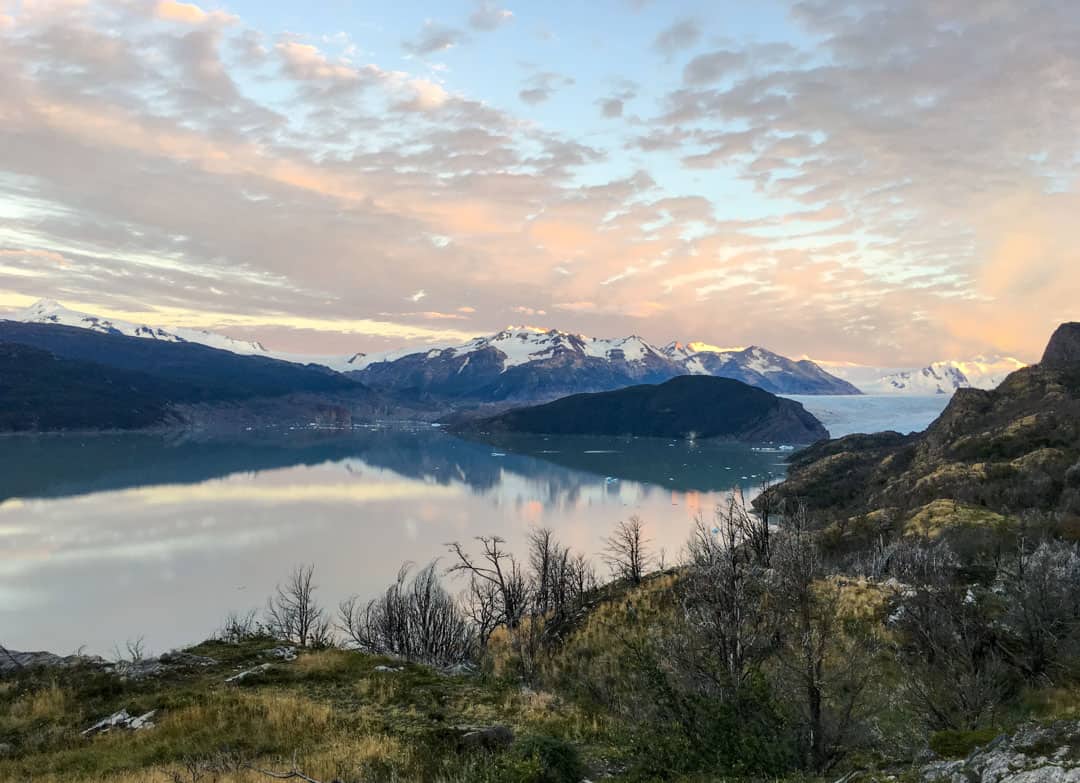
Despite John’s sore feet, we make good time on the return journey and while we’re climbing for much of the first half, it feels easier than the trek up from Paine Grande yesterday. Maybe it’s because we’re on the home run, even though the thought makes us sad.
Our journey back to Paine Grande takes us 3 hours and 15 minutes, 30 minutes less than yesterday’s hike in the opposite direction.
We haven’t eaten breakfast and we’re starving by the time we arrive. We were planning to grab something to eat at the restaurant at Paine Grande, but we discover it’s closed between breakfast and lunch.
We make do with our leftover trail mix instead, which is a bigger deal than you might think: we packed way too much of the bitty hiker’s snack and after five days we have a serious love/hate relationship with it.
Fortunately, there’s now a mini market at Paine Grande, which is apparently open from 7am. But if you’re setting out really early like us, perhaps have something you can eat on the go for this final morning.
Tickets and times for the Lake Pehoe ferry between Paine Grande and Pudeto
The catamaran that crosses Lake Pehoe between Paine Grande and Pudeto operates from September to April.
Departure times change from month to month, as do the number of daily sailings. So be sure to check the boat schedule when you’re planning your W trek itinerary, and adjust your final day hiking start time to ensure you arrive back at Paine Grande at least 30 minutes before the boat is due to depart.
Importantly, you must now book your ticket for the catamaran ahead of time. You can do this online at the Catamaran Lake Pehoe website, and we recommend doing this well in advance.
We’re told it is possible to buy tickets at the piers in Pudeto and Paine Grande using a QR code. However, we’re yet to confirm whether there are always seats set aside for lastminute buyers. To be on the safe side, we would book online well ahead.
The cost for the 2024-2025 season is 26,000 CLP or US$30 (each way) and the journey takes around 30 minutes.
We board the late morning catamaran for our return to the eastern side of the park. The boat trip across Lake Pehoé offers spectacular views of the entire mountainscape we’ve spent the last five days traversing. It’s an epic perspective of the W panorama and a mesmerising finale to our W trek itinerary.
If the weather is nice, we totally recommend taking a seat outside on the catamaran so you can properly admire the breathtaking scenery.
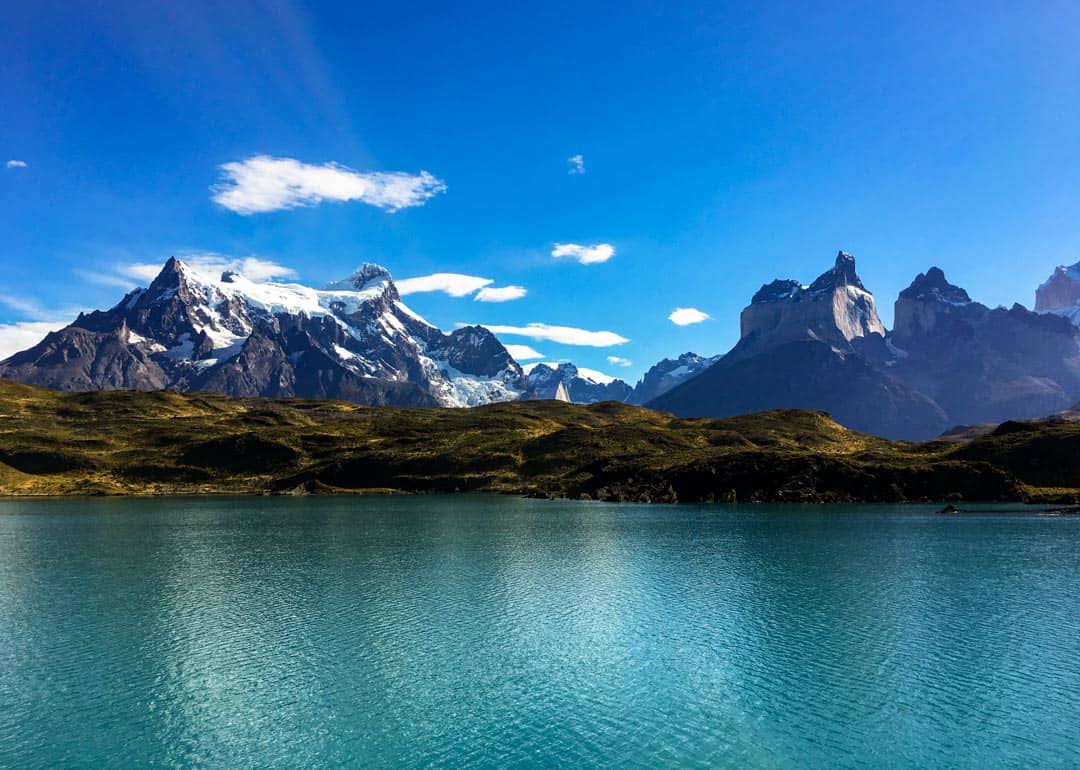
Disembarking the ferry at Pudeto, we grab a coffee from the lakeside café (open from October throughout the trekking season), take a seat in the sun, and enjoy our last moments in Torres del Paine while we wait for our bus.
Travel tip: In addition to checking ferry times for the catamaran between Paine Grande and Pudeto when you’re organising your trek, it’s also worth checking the bus connections to and from Pudeto, so you can work out the best approach for your final day on the trail.
From Pudeto, the bus makes its way back to the Laguna Amarga Ranger Station to collect hikers finishing their trek at the eastern end of the park. From there, we settle in for the return two hour bus journey to Puerto Natales.
Tonight, back in Puerto Natales, after a good hot shower and a lamentation on the ridiculous amount of trail mix we’ve got left over, we head out for a celebratory drink.
Our legs might be seizing, our knees protesting and we’re beyond exhausted, but we’re buzzing with the sheer thrill of having completed this epic trek. We’re already talking about when we might come back and hike the W trail again, or better yet, take on the longer O circuit.
However we do it, trekking in Torres del Paine is one nature experience we’re keeping firmly on our bucket list.
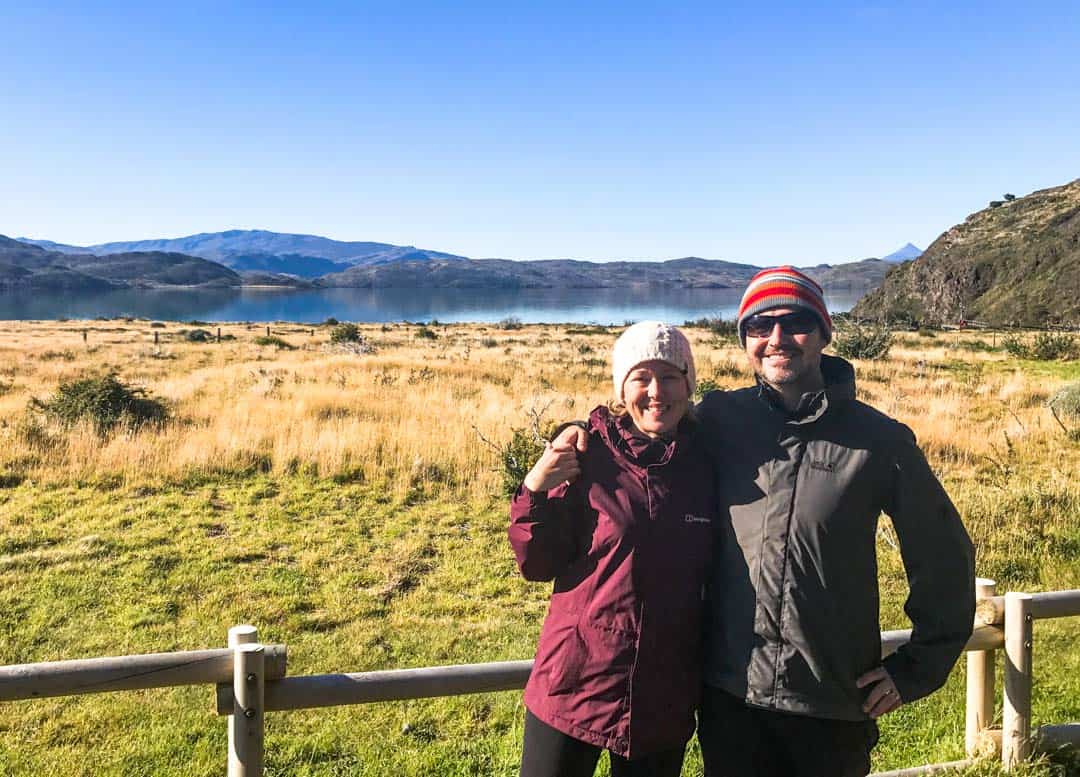
Got any questions? Have you trekked in Torres del Paine recently?
We’d love to hear from you, drop us a message below.
For more exciting experiences and things to do in this incomparable part of the world,
head to our Chile page or our South America section.

Hi, I Loved reading this entire article, and it has given me so much clarity on this hike. I am planning this with my husband for the End of November.
We are thinking of staying at Hotel Torres for one day before we start the hike. We want to rest from our long travels, so we will leave all our luggage there. For the first hike day, how much more will we walk if we decide to come back to Hotel Torres on our first night(Las Torres), or should we just stay in Chileno?
Also, which camera did you use to take these beautiful shots?
Hi Bhakti, many thanks for your message. Based on our own hike, it’s around 5km from Hotel Las Torres to Chileno (this took us around 2 hours) and then a further 4.4km up to the Las Torres mirador (which took us another 2 hours). So if you were to return to Hotel Las Torres on the same day, you’d be doing the same distance again in reverse and looking at a total hike of around 18.8+ km and at least 8 hours (hiking only), noting this time will vary depending on your own hiking pace plus additional time for breaks along the way and time at the mirador.
It does make for a long day but if you’re staying the first night at Hotel Las Torres, you can get onto the trail early, plus the sun sets later in November, giving you lots of daylight hours.
It would also be worth doing some online research to see what others are saying about doing the Hotel Las Torres – Las Torres return route on the same day.
Thank you also for your kind words about the pics in our post. We hiked with a Canon EOS but many of these shots were taken with our iphones! You really can’t go wrong when the scenery is as beautiful as this.
Enjoy your trek!
Really helpful guide, thank you. Do you know how far in advance you can book accommodation. Looking for December this year / Jan 2026 and can only seem to book April this year at the moment.
Hi Iain, thanks for your message. Bookings have in the past opened around May/June (and later) for the next trekking season, but reservation opening dates and what’s released when is very much at the behest of the companies running the refugio/camping zones (Las Torres Patagonia and Vertice Travel). I’d suggest contacting both companies directly for an indication of when they intend to open bookings for the 2025/26 season, and also keeping a close eye on both sites over the coming months. All the best!
EDIT: Hi again Iain, thought I’d share the following I received from Vertice Travel on 18 March: “the reservation system for the upcoming 2025-2026 season is not yet available. The estimated opening date for reservations for next season is before the end of the month. There is no exact date, but you can write to us again next week.” Still waiting to hear back from Las Torres.
Thank you. Amazing.
Vertice is open! I found out through social media (Instagram)
Just waiting on Las Torres now, they told me sometime in April/May.
We are planning to go to for February 2026 🙂
Awesome, thanks for the update Lauren!
Hi Danielle and John,
I want to travel in W trail.
I wanted to ask if it is possible to cook food yourself in a French campsite on the trail.
Thank you
Olga
Hi Olga, portable stoves can be used in the designated areas/shelters at each campsite, including Frances – cooking is only allowed in these designated areas. The exception is the Chileno sector, where stoves are banned from use due to the risk of forest fire. Happy trekking!
Hi Olga! When are you planning to go? I am looking for 2 other people to share the costs with me and my partner
Thanks so much for this, its brilliant. We found it really useful when we did the W trek a few weeks ago, it was amazing! I also sent this to a friend who depended on it!
Just to add, because I know at least one person has asked, we found boiling water at all the campsites we stayed at. We struggled to find this info before we went but we’re glad we didn’t take a stove as some people suggested on reddit, we were carrying enough as it was.
In Centro the boiling water dispenser is in the room where you check in for camping. The only annoying thng is that they don’t open this room until 9:30am but they did let me in a bit early just to get hot water.
Frances – its in the cafeteria.
Paine Grande – there is one in the shop next to a tip jar. There is also one in the restaurant that you might be able to use but not sure whether you’re supposed to without meal tickets.
Grey – same again, one in the shop where they ask for tips and one in the restaurant.
Hey Will, huge thanks for sharing this info about access to boiling water, it’s great to hear latest updates on the W Trek from fellow trekkers!
We’re also still trying to confirm whether trekkers can buy catamaran tickets when they turn up at the docks in Paine Grande and Pudeto easily enough – is this something you did or came across during your trek?
Thanks again and cheers also for the lovely feedback, we’re stoked you found our post useful and that you had an amazing hike!
Happy travels,
Danielle & John
Thank you!
We had bought tickets online to get the boat from Paine Grande to Pudeto (before we even went to TdP). It looked like most other people had too. There were a few people in the queue who didn’t have tickets, they were taken to one side and it looked like they needed to wait for the next boat. So I’d recommend buying tickets in advance if possible.
Thanks so much Will, very good to know! Cheers!
Hello! Thank you so much for posting this – I am planning to hike the W trek in late November this year over Thanksgiving. It’s good to know that you would spend more time in the French Valley if you were doing the trek again – would this itinerary potentially make sense?
Day 1: Hike to Torres base and sleep in Chileno
Day 2: Chileno to Cuernos
Day 3: Cuernos to Britanico viewpoint to Frances
Day 4: Frances to either Paine Grande or Grey
I want to leave enough time in Grey to do the swinging bridge section and possibly Kayak, so I think I will likely need 1 night there, so I’m trying to determine if it’s feasible to hike from Frances straight through to Grey, or if that would be too much and if it would be better to just do a short day on Day 4 to Paine Grande, then hike to Grey the next day on Day 5 and spend the night, then hike or take the boat back to Paine Grande on Day 6?
Hi Greer, excited to hear you’re planning to hike the W this coming November! Your itinerary makes sense given you’re looking to build in plenty of time at Grey for the swinging bridge/s and kayaking. It’s possible to hike from Frances through to Grey in one day – it would be a big hiking day, around 21km and appx 7 hours of hiking plus breaks. But doing it that way would give you all of Day 5 to hike out and back from Grey to the suspension bridges (apparently the first bridge is around 30-40 minutes from Grey and the second around an hour beyond the first bridge, so you’re looking at min 3 hours return plus time for pics etc) and then join an afternoon kayaking tour. Then head back to Paine Grande on Day 6.
The alternative is to, as you suggest, spend the night of Day 4 in Paine Grande and set out very early on Day 5 from Paine Grande to Grey. You’d need plenty of time to hike to Grey and beyond to the suspension bridge/s and back by early afternoon for a kayak tour. That’s a lot of hiking and kayaking for one day and potentially a bit time-pressured if you’ve got a tour to be back for.
Just a note also that the boat from Refugio Gray doesn’t go to Paine Grande, it travels across Lake Grey to Hotel Grey. Boat access to Paine Grande is only via Lake Pehoe from Pudeto. So if you’re heading back to Paine Grande from Grey, you’d need to factor that hike time into your itinerary too.
If you’ve got the time to slow the pace and enjoy the experiences without rushing, we’d personally go for that!
All the best with your planning and happy hiking!
Thank you for this incredibly detailed and helpful post. I’m planning a really similar trek 🙂
You mention locking up your bags at Italiano, but then say on your return they were just in a pile — I have heard it’s just cubbies/a pile from other sources too. I was wondering if you can speak a little bit more about how you secured your packs when you left them and took a day pack? Both at Italiano and other instances that you left packs at other refugios during out-and-back hiking. (Or do folks just carry all valuables in the day pack and the big pack is essentially unsecured?)
Also how big of a day pack did you use (just 1 between the 2 of you?)? Any recommendations on what to use? I’m debating spending a bit more $ (and weight) to get a day pack that attaches to the outside of my existing big pack, so that it’s easy to pack it all before going out and just detach and re-attach… versus a super light foldable/stuffable one.
Last Q: For some of the days, there is significant downtime after hiking. I am planning to bring a deck of cards, but debating in terms of weight and the inconvenience of having valuable/wet-intolerant electronics on whether to bring anything more for entertainment (e.g. Kindle or iPad). Any thoughts on this?
Thanks again!
Hey Sora,
Thanks so much for your feedback, it’s very much appreciated! Thank you also for your query about leaving packs at Italiano and other places on the trek; I’ve adjusted the text here so it’s clearer; we actually only left our big daypack here (making sure all its access points were locked) and carried our smaller daypack with us.
We were on a long travel stint when we hiked the W, and travelling with two large backpacks plus two daypacks. We didn’t want to tote the large packs through Torres Del Paine (and we also wanted to leave most of our longer-term travel gear back at our hotel), so for the hike, we hired a 60L top loader backpack in Puerto Natales, and also carried one of our decent-sized daypacks; this was more than enough for clothes, food, camping and camera gear for the two of us.
At Italiano, there wasn’t anything to lock packs to, we just moved all our valuables into our daypack with lunch, and made sure our big pack was locked up. We also did this at Chileno. To be honest, I’m never stoked about leaving our gear (and would probably have hesitated if there wasn’t a ranger at the station), but we just made sure there was nothing important in the big pack and that it had good locks on it. I would note that we also travel with a cable lock and would have used this had there been something to lock the big pack to.
In relation to downtime, we actually found that by the time we’d arrived at a campground, got our tent organised, had a scout around and/or a drink at the lodge bar, showered, made dinner and then cleaned up, we were totally shattered and pretty much straight into our sleeping bags! Charging electronics is a consideration if you’re camping over the five days – we carried a solar charger and power banks.
Hope this helps and all the best for your W trek!
Did you book each night yourself or sign up for a package deal? Seems some savings booking directly.
Hi Bobbie, we personally booked each night ourselves direct with the accommodation providers in the park (Las Torres Patagonia and Vertices Travel), it just required a bit of dates flexibility working across two separate booking providers to sort an itinerary that suited us.
Cheers, Danielle
Hello,
We are a group of 65 yr olds, experienced hikers, wanting to do the W trek in late Nov 2025. We are a little worried by the first day; our travel agent is suggesting we depart PN on the first bus, entering the park and leaving our packs at Central Refugio, hiking to the Mirador Las Torres and returning to Central for the night. Is this too much for one day? Would we be better off staying an extra night at Central and starting out our second day early mnorning to do the Mirado kie as oppose to starting at 11:00ish? We don;t really have an extra day but we could make it happen if recommended. Your blog has been extremely useful in our planning. Thank you
Hi Catherine
Thanks for your message and great to hear you’re planning to trek the W next year!
We stayed at Refugio Chileno on Day 1 rather than returning to the Welcome Centre/Centrale and we hiked for around 6 hours, plus an hour for lunch and an hour at the Las Torres mirador. Based on our pace, it would have taken us around 2 more hours to get back to Centrale from Chileno, so appx. 8 hours of hiking all up.
This aligns with what we’ve seen in recent forum reports from others who have hiked Centrale > Las Torres mirador > Centrale in one day – the average for relatively fit hikers would appear to be around 8 to 10 hours, depending on pace, how often you stop, how long you spend at the top (30 minutes or so seems to be typical), and potentially how busy it is on the trail (noting it does get quite a bit busier as the buses from Puerto Natales start to arrive).
It is a big day but the bonus is that sunset in late November is around 9.30pm, so even if you set out around 11am, you have a good 10+ hours of daylight to work with.
It’s definitely worth checking out forums such as TripAdvisor and Reddit for more insights from other hikers who have hiked Centrale > Las Torres > Centrale in one day as this may help further with your planning.
All the best and we wish you and your group a wonderful time on the W!
Danielle & John
The information you provided is extremely helpful. We are visiting TDP in January 2024. One question I have is: We are taking the boat from Hotel Lago Grey one way to Refugio Grey and staying overnight at Refugio Grey. We have two options the next day. One is to hike to Paine Grande and then take the catamaran to Pudeto and drive back to our hotel. The second option is to hang out for the day at Grey and hike around Grey or maybe do the kayak excursion and then take the boat back to Hotel Lago Grey where we would have left our rental car and then drive to our hotel. In your opinion which option would be more scenic? We will be hiking from Paine Grande to Frances and then Chilean a few days later.
Hi Bob, thanks for reaching out, your trip sounds great! Tough questions though, as we love the sound of all your options!
Kayaking on Grey Lake is something we really wish we’d had time to do when we were there, so I know I’d personally lean towards that if I had the chance. As you’re also planning to hike Paine Grande to Frances and Chileno during your visit, kayaking would be a nice way to mix up your experience of TDP (and get you closer to the glacier and ice bergs). As you said, you could spend the morning hiking around Grey and do part of the trail south towards Paine Grande for a taste of that stretch of the W, or north of Grey towards Paso and the glacier.
Having said all that, the half-hour Lake Pehoe catamaran is a wonderful, relaxed way to take in the full epic panorama of the Paine Massif, and the hike between Refugio Grey and Paine Grande is beautiful. Also a solid option.
I guess it comes down to what you most feel like doing and/or how active you want to be. Either way, it’s a win.
We’d love to know what you decide! All the best with your planning and have a wonderful time in TDP!
~ Danielle
Hi there! Thank you so much for this detailed itinerary, it really helped us a lot for our planning and we are looking forward to do it in April 25!
Just a few questions please. May I know typically how long in advance would I need to book my bus tickets please? Would it be possible to purchase on the actual day instead or would that be too risky?
In addition, for the last day back to Pudeto, what if the morning Catamaran slot is sold out? Would you recommend taking the 6.40pm one or are there any other options to get back Puerto Natales earlier please?
Thank you and look forward to your responses!
Hi Chong Yong, thanks so much for your message and feedback!
With regards to the bus, we would highly recommend booking your tickets in advance rather than waiting till the day of departure. With TDP becoming ever more popular, you don’t want to run the risk of available services being full on the day, even if you’re travelling later in the season. Perhaps check the bus company terms and conditions to see if there’s scope to change travel dates if needed.
We’re still seeking confirmation as to whether the Lake Pehoe catamaran sets aside tickets for walk-ups on the day now that it has online booking. We’ll update this in the post as soon as we know more. If you book the PM return just in case, you can make changes or get a refund for a fee (see the ‘policies and conditions’ page on the catamaran website).
The overland alternatives to taking the catamaran are to hike east back to Laguna Amarga for the bus back to Puerto Natales, or hike south from Paine Grande to the Park Administration HQ (around 18km/5hrs) and take a bus from there back to PN. The map we link to in the post shows these trails.
There’s also a boat tour of Grey Lake that departs from Grey Refugio and travels to Hotel Grey, where buses pick up for PN.
If you’re planning to stay overnight at Refugio Paine Grande, it might be worth contacting them directly for any advice they can provide about the catamaran.
Hope this helps a bit, and all the best with your planning!
What a super break down of your trip! We are planning to do the W and then go to El Chalten. I was wondering if after your trip you flew back out of El Calafate to Buenos Aires or if you bused back and flew to Santiago. Thank you
Hi Pauline, thanks for your message! We did the W Trek as part of a much longer overland trip through South America, so after finishing the trek, we travelled to El Calafate and El Chalten by bus, and then from there we continued on north by bus to Bariloche.
Happy trip planning and we hope you have a fantastic trek!
What a exciting blog to read with so many helpful insights! We are currently planning a “half a W-Trek’ focusing on the Western portion for 3 day/2night stay, one in Britanico and one in Refugio Los Cuernos before returning to Pehoe Lake.
Hi Reinier, thanks for your message and kind words! Your trip sounds great, we hope you have a magical time exploring the western half of the W! All the best, Danielle & John
Thank you so much for this rundown – working on booking for this winter now. Would love your opinion about 2 things:
1. On the day we’re hiking into Grey, I was thinking about trying to add the glacier kayak excursion on that afternoon – do you think that would all be doable in 1 day? Were you aware of folks who did it?
2. On the last day, I was thinking we’d hike out, take the catamaran, bus back to Puerto Natales, and catch the 5:00pm bus to Punta Arenas. Based on your experience, do you think that would be doable?
Hey Mark, Thanks for your message – great to hear you’re planning a W trip!
The kayaking sounds awesome. It certainly sounds possible to hike to Grey and do the kayak tour on the same day, assuming there are tours running later in the day? As an indication, it took us around 3 hours 45 mins to hike the 11km from Paine Grande to Grey at an average pace. You may do it quicker or slower depending on your own pace, but if you aim to set out from Paine Grande early morning, you should reach Grey campground/lodge by late morning/early afternoon, which would potentially give you time to check in to the campsite/lodge and then join a late afternoon kayak tour? I’d personally make sure there was a good amount of time between my estimated arrival and the tour departure just in case, that way you can enjoy the hike to Grey without rushing.
We usually err on the side of caution when it comes to transport as well, as while most of our bus travel in Chile/Argentina was issue-free, we did experience occasional bus delays and lastminute cancellations. Bearing in mind the bus from Pudeto to Puerto Natales takes a couple of hours, we’d be looking to put in a decent buffer between that and the Punta Arenas service, just in case you’re held up at any point along the way. Less stressful!
All the best with your planning and have a wonderful time in Torres del Paine! Let us know if you do end up hiking and kayaking on the same day!
I been to Asia a couple times but never to enjoy much of the nature. Your destinations and experiences have me wanting to explore more of the hiking trails abroad. Thanks for sharing!
Cheers Bryan, happy travels!
Thanks for your info, it helps a lot. I’m planning to do W trek in coming January. If I book the camp, can I also use the facilities in the shelter (like shower and toilet)?
Hi Karen, all of the campsites along the W have dedicated facilities for campers, including showers and toilets. Some have cooking areas for campers as well. Happy planning and have a wonderful trek in January! Cheers, Danielle
Great website! We’re hoping to do this February/March 2025, and are wondering how best to spend our time on either side of this hike. Did you travel to El Calafate and El Chalten while you were in the area? Or do you recommend other areas down there? Any advice greatly appreciated!
Hi Lisa, thanks for your message! Fantastic to hear you’re planning a trip to Patagonia! Besides the W Trek, there are various activities you can do in and around Puerto Natales and Torres del Paine, like boat trips on Grey Lake to Grey Glacier or horseback riding.
We most definitely did travel to El Calafate and El Chalten after our trek and absolutely recommend, especially if you’re keen to get out on some further hikes. We bussed from Puerto Natales to El Calafate and the next day did a day trip to the Perito Moreno Glacier, which is an absolute must. From El Calafate, we travelled by bus to El Chalten (the panoramas on the bus ride in are wow – try and get the front seats!) and spent a good couple of days exploring this gorgeous area and just hanging out. There are a range of hikes you can do out of El Chalten – the day hikes to Laguna de Los Tres and Cerro Torre are epic.
If you head south from Puerto Natales to Punta Arenas, you can do day trips to see King penguins, Magellan penguins, whales and dolphins, so that’s another option.
Have a wonderful time and happy trip planning!
Cheers, Danielle
In Calafete, which tour to Perito Merino glacier was a must-do? We have options of ice trekking, kayaking, safari azul, or Mayo do Spirit?
Hi Lana, difficult choice! All of those options sound great – we did a boat trip out on the lake to the glacier terminus and that was fun, though very sedate compared to ice trekking or kayaking – both would be an amazing way to experience this incredible place. All the best with your planning and have a wonderful time!
Thank you for sharing your Patagonia insights! I found it very thorough and incredibly helpful. I we are planning our trip for October 2024. I have a question. How did you book your meal plan?
Thanks!
Kim
Hi Kim, thanks for your feedback, we’re glad you’ve found our post helpful! When you go through the booking process for each accommodation (including camping) along the trail, you’ll have the opportunity to add meals as part of those bookings. Links to the accommodation providers are in the post. Good luck with your planning and happy trekking in October! Cheers, Danielle & John
Hi thank you so much for this detailed blog. It appears that one would have to stay at Frances camp if going east to west in order to shave hiking time on day 3. Is there a bus company through which we have to pre-book a bus ticket from Pudeto ferry to Las Amargo? Or is it a shuttle service?
Do you have any idea if booking a guided tour via Las Torres means that they carry your heavy rucksacks??
Is the last day at Grey really worth it ? Or would you rather end the trek on day 4?
Thank you!
Hi SK, thanks for your message. Until the CONAF Italiano camp reopens, Frances camp is the closest camp to the Frances Valley so yes, it is the best bet timing-wise for getting in and out of the Frances Valley and on to Paine Grande on Day 3 if travelling from east to west. You could also stay at Los Cuernos, but that would add around 1.5 hours to Day 3.
The buses running from Puerto Natales to Torres del Paine drop off and pick-up from Laguna Amarga and Pudeto. When you buy your bus ticket to Torres del Paine, you’ll note where you’ll be getting off and on again (it will depend on your itinerary, but for us, travelling from east to west, we got off at Laguna Amarga and boarded at Pudeto on our return. Check out the section in our post on bus tickets to and from the park for more info. There’s a shuttle that runs between the Laguna Amarga ranger station and Hotel Las Torres for a fee.
We would suggest contacting the tour company you’re interested in for advice about whether porter services are available on their guided tours. We left most of our luggage in one of our backpacks at our hotel in Puerto Natales and carried only what we needed for the trek to keep the weight down.
We personally feel that every leg of the W is absolutely worth it – the scenery is superb throughout. Five days gave us just the right amount of time to enjoy the whole trail without pushing too hard. To do the trek in four days, you’d likely need to compromise on either the full hike into Frances Valley or the Grey leg in order to reach camps before dark, and we wouldn’t want to skip either. But that’s us. If four days was all we had to trek, we would possibly leave Grey but we’d have to make sure we did a boat tour out to the glacier instead! 🙂
All the best with your planning! Cheers, Danielle & John
This is seriously one of the best breakdowns I’ve read. Patagonia is one of three “Someday” treks I have on my list to head off on once my son is a little bigger and can carry more of his own gear. We’re building up now with longer and longer trips around Central/Eastern Europe
Love this site!
Thanks for your message Brian, we really appreciate your feedback. So cool that you and your son are already hiking together, and what an awesome bucket list adventure to look forward to with him! Happy trekking and thanks again! Danielle & John
Hi,
Do you have a map with the accommodations you booked or where you rented out tents/gears?
Planning on doing this solo in June!
Thanks!
Hi Erika, thanks for your message! There’s a trail map available at the official Torres del Paine website: https://parquetorresdelpaine.cl/mapa-2023-2024/ – it shows all the accommodations/campsites along the trail. You can also find links in our post to the accommodation providers we booked our campsites and camping gear through.
As you’re considering a June trip, we’d also encourage you to check out the official Torres del Paine website for information about winter hiking regulations – https://parquetorresdelpaine.cl/permisos-especiales/. Many of the accommodations and trails close over winter and while you can visit the park, we understand it’s mandatory to have a guide for the W Trek and the trek to the base of Las Torres between 1 May and 30 August (though the timeframes can change depending on weather). All the best with your planning! ~ Danielle
Hello Dan,
What a great find this was. Thank you so much for writing it. I’m looking to mimic your trek with some modifications. I will very likely have a car rental when I arrive into Punta Arenas.
My plan is to drive myself and 2 others into the park and leave the vehicle parked at the welcome center or hotel (unsure if this is allowed).
At the end you mention that you ferry to Pudeto- then catch a bus that swings by Laguna Amarga into Puerto Natales.
Is there a bus that goes directly back to the welcome center or hotel from Pudeto so we can get back in my rental? It looks like the Laguna Amarga ranger station is about 8.5 km from the welcome center.
Or is it best to just shuttle from Puerto Natales for the whole thing and leave the rental somewhere in town?
Hi Bruce, thanks so much for your message and feedback! Very good question re. parking – based on our limited research into this, our understanding is that you can leave your car at Hotel Las Torres while you trek if you’re a guest there, otherwise, cars can be parked at the nearby Welcome Centre. We’ve also seen reference online to a small car parking area at Pudeto, so in theory you could arrange bus tickets from Pudeto to Laguna Amarga, and from there get the hotel shuttle to Hotel Las Torres/the Welcome Centre. I would suggest posting your question on Tripadvisor and hopefully someone has done something similar recently and can provide latest info. It might also be worth contacting Hotel Las Torres and asking their advice; no doubt they get questions like this frequently. All the very best for your trip planning and the trek itself – it’s an unforgettable experience! Cheers, Danielle & John
Thank you so much for the great information. I’m a long term planner and we’re looking to book for our family of four, Christmas 2024. I found this blog really really helpful in hiking cost effectively.
Thanks Again!
Hi Melissa, thank you so much for your message, we’re really happy you’ve found our post helpful in your planning. Also very excited for you and your family – what a fantastic Christmas experience! We hope you have a really wonderful time hiking the W, it’s just such an incredible place! All the best and happy hiking! Danielle & John
Thanks for the article, I find it very useful. I have just booked the circuit trail for this April. About that: I looked into using Booking Patagonia for the reservations, and it works really well. Though, there is a downside: they charge an extra $90. You’ll notice this at the very and of the booking process, which I found quite frustrating. For me that was a reason to book directly at Vertice and Las Torres Patagonia, which works fine.
Hi Valentijn, thanks so much for this update, that’s really helpful to know! Thanks also for your feedback on our post, we’re pleased you’ve found it useful. All the best for your upcoming trip in April, have a sensational time and happy hiking! Cheers, Danielle & John
Thanks for the great write up. The details are useful and your descriptions are inspiring. I’m leaving for Chile in a couple days and your post just added to my excitement.
Hey Mike, thanks so much for your feedback, we hope you have a really fantastic trip. Chile is an incredible country, one of our faves!
Cheers, Danielle & John
Hey Dan,
Thank you for that informativ Blog!
I have a question: are there any possibilities to heat up some water in the Refugiés without a stove?
All the best
Sophie
Hi Sophie, thanks for your message!
As we had a cooking stove (and booked meals at Chileno where stoves can’t be used), we can’t personally say for sure whether hot water is currently available at all of the stops on the route. That said, we did find a trekker’s report online from late 2023 noting that they were able to access hot water (not boiling) through the coffee/tea dispensers at each of the refugios they stayed at, which they used for their dehydrated meals. Would suggest seeing if there are other trip reports from this season, or posting on a forum for latest updates. Or perhaps hire a stove in Puerto Natales and buy a gas canister just to be on the safe side! We’d love to know what you find out!
Have a magic time trekking the W!
Cheers, Dan & John
Hi guys. Thanks for all the detailed info. Just wondering if you could give an estimate of how much it cost for the W trek. I am being quoted $1180 per person for 4 nights and five days starting 12th February with this included:
• camping accommodation with all the equipment
• all the meals
• transportation from/to natales-park
• park entrance
• catamaran
• welcome kit
Not sure if this price is really high or if it would work out as that much if I book everything myself separately anyway.
Many thanks
Hi Aoife
Thanks for your message and feedback – we’re really excited for your trek in Torres del Paine.
We were travelling long-term when we did the W Trek so we went out of our way to keep costs down by booking the campsites directly, carrying some of our own camping gear and bringing most of our own food. Travelling as a pair also helped as the single supplements can add quite a bit. We’d also note that, like everything, prices have hiked post-Covid.
We’ve included some costings in our post but not many as we’re conscious things can change quickly (plus there are so many potential cost combos for accommodation/food, it’s tricky to provide a general estimate). As the bulk of your costs will be in the camping, gear and food components, you might consider checking out the latest price lists for camping and food package options on the Vertice and Las Torres Patagonia websites; that would give you a sense of costs in the context of your quote. Given how quickly accomm/campsites book up for the season and the challenge of trying to coordinate an itinerary across multiple websites, having a third party making the arrangements, while costing more, would take the hassle out of that.
All the best with your planning and we hope you have a sensational time trekking!
Cheers
Danielle & John
Did you use the tour company? If so, who was it and did you enjoy it?
Your hikes sounded amazing. We are going in Feb and I wasn’t sure what to expect. Sounds like I should do some training!
Do you recommend stiff hiking boots to navigate the big rocks or are light hikers enough support?
Thanks for sharing,
Karen. Canada
Hi Karen, many thanks for your feedback! To be honest, if you’re a regular walker/hiker, you may find the W Trek a breeze – we met plenty of people who barely cracked a sweat, lol. As irregular hikers, we found some of the steeper sections a little more ‘breath-taking’ but still very do-able. We both wore regular lightweight hiking shoes and they were fine (apart from John developing blisters towards the end), but we also saw people in solid boots. I guess it depends on your preference. We did find having a hiking pole each was useful on some of the more uneven terrain like the rocky climb to Las Torres. We’d love to hear about your trek when you get back – have a fantastic time! Danielle
Going in February, cant wait. Did you know how anyone who did the kayak at Grey and talked about there experience?
Hi Efren, that’s so exciting! We don’t personally know anyone who has kayaked at Grey but we wish we’d had time for it – what an amazing experience! The lake is beautiful and the glacier is epic! If you do kayak, we’d love to hear about it! Have a fantastic time, Cheers, Danielle & John
Awesome Post!
I’m looking at doing this the same direction as you guys did around the same time in 2025.
You mentioned availibilty determined your campgrounds; that being said would you change any of your stays if you could in retrospect? Maybe saw some better campgrounds/lodges along the way that you wish you could have booked had there been availibilty?
thanks!
Hi Chris, thanks for your message and good question! We were on a long travel stint when we did the W Trek so we opted for camping to keep our costs down, plus the campsites we ended up with proved to be very well located for a five-day itinerary. That said, all of the lodges and refuges looked quite nice so if we were to do it again (and we hope to!), we would consider adding some lodge/refuge stays, following the same itinerary. Location-wise, the Cuernos and French refuges would be good alternatives to camping (though these are beds in dorms, which is less appealing to us). We would definitely consider the Cuernos Cabins (2-3 people per cabin), especially if we were planning a longer stay in the French Valley! We’d also consider staying at the lodge at Grey next time as, of all the campgrounds, this was probably our least favourite (plus we were very ready for a bed by that stage!). Overall, the quality of the campgrounds/refuges throughout the park is very good and we were really happy with our camping experience and itinerary. Best of luck with your planning and we’d love to know how you go! Happy travels!
Wonderful description. We are going in Jan 2024! Looking forward to it.
Hi Kishore Joshi, thank you so much for your feedback, we hope you’ve found it helpful! Wishing you a fantastic W Trek, it really is the most incredible place! Happy travels!
Hi! How much cash would we need, knowing that the bus and entrance are paid for and also full board meal plan at the refugios is booked?
So for snacks, water or other costs etc?
Do they accept USD or should we have it exchanged? Thanks!
PS, did you also really use ‘poop bags’ for your used toilet paper along the way? 😅
Hi Frauke
Thanks for your message. We carried both USD and Chilean pesos with us just in case, and we were able to use credit cards at the refuges. We paid for the shuttle from Laguna Amarga and the catamaran from Paine Grande in pesos, though we have read that the catamaran operators may take USD in high season. It’s handy to have pesos for smaller purchases like snacks. We carried a refillable bottle and filled up in streams and at the refugios, so we didn’t purchase water.
We have packed degradable doggy bags for carrying out toilet paper on past hikes! 🙂 On the W Trek though, we carried a loo roll and some trusty Ziploc bags, but we mostly just made strategic use of the campground facilities!
Happy trekking!
Hi John and Dan
Thanks for such good info.
Is it safe doing it self guided ? Thanks
Hey Iris, thanks so much for your message, we hope you found the post helpful. We found going self-guided very easy – the trails are well trodden and during the peak season, there are plenty of other people hiking too (guides are mandatory in winter). Plus all trekkers have to stay in the designated camping and accomm areas so there are others around and you can stay in dorms if you’re not keen on camping. Conditions can vary dramatically though and it is the great outdoors, so having appropriate gear is essential and hiking with friends is good idea though we hear lots of people do it solo. Everyone we met en route were friendly, encouraging and helpful too. We absolutely loved the hiking the W and hope you get to experience it too! Happy travels! Dan & John
Hi!
This is really helpful thank you so much. Did you have much hiking experience before you took this on? Would you recommend any training prior to going? What size backpack would you recommend taking?
Thank you so much
Hi Jo, thanks for your kind words, we’re glad you found the post useful! We’re casual hikers and while we’d done a bit of hiking before the W, it was certainly one of the ‘biggest’ hikes we’d done. We definitely tried to up our walking/hiking game before the W in preparation and glad we did as we personally found some of the steeper, sustained-climbing parts of the trek relatively tough – we just took our time and had lots of breaks; necessary anyway to take in the gorgeous views! I carried a 30L daypack and John carried a 50L backpack – between us we carried everything we needed for the five day hike, but I would note that we didn’t have to carry tents, sleeping bags or mats as we hired these. We hope you have the chance to hike the W trek, it remains at the very top of our hiking list! Happy travels!
Thank you all for this awesome breakdown and information! We followed it exactly to book our accommodations and plan to do the trek end of March. Thanks again!
Hi Kristen, thanks so much for your feedback! We’re stoked you found our post helpful and we’re very excited for your upcoming trip. Torres del Paine is sooooo spectacular, wishing you a fantastic trek – let us know how you go! ~ Danielle & John
Thanks Dan for the great details and info.
Hi Kristen. I am doing the trek around of march with a friend. We are travelling from Perth, Australia. Would be great to collaborate in planning.
Thanks Bikash
Hello! This page is fantastic, thank you so much. We are looking at November and can be flexible in terms of dates. Did you book your accommodation first? Are there any other considerations i.e. tickets or entry to the park? Or should we just arrange accommodation and go from there? Do you mind sharing how much you paid approximately for your camping accommodation? No worries if not. Thanks 🙂 Amie
Hi Amie, many thanks! We booked our accommodation first and a couple of months in advance. Site availability ended up driving our approach to the trek – so it’s good that you have flexibility! Would definitely get in as early as possible to book. Tickets for the park itself are arranged at the park entry office, but you will need to have the accomm bookings in place (and evidence of them) when you get to that point. So it’s important to book the accommodation and bus tickets to the park in advance. Bus tix you can buy when you get to Puerto Natales, but try and do that as soon as you arrive rather than on the day you intend to travel to the park. Prices for camping and cabins may have changed since we trekked, but if you head to the accomm links in our post, you’ll be able to find out the current prices as it’s all bookable online. Hope that helps and have a fantastic trek! Cheers, Dan & John
Thank you for the detailed information. We are trekking this exact route this March 2020!
-Jackie
Hi Jackie, thanks for your message, we’re really happy you’ve found it helpful for planning. Hope you have a sensational trek!
Thank you so much for the detailed guide! This is really helpful 🙂
Hi Katherine, thanks for getting in touch! We’re really pleased you found the guide useful – happy hiking!
Hi,
How did you book the campsite ? I unable to locate the source to book just the campsite
Hey Rajesh, thanks for the message.
The Camping areas are run by three different operators in the park, and you can find links to all three operators in our post.
All three operators’ websites have information about their camp sites, and how to book.
Hope this helps.
John & Dan
Exactly what I’m looking for, thanks! Chileno and Los Torres always been there on my bucket list, now I know where and how to start.
Awesome, thanks Rika, we’re really pleased you’ve found it helpful. It is the most spectacular walk – even if you just did the one leg to Las Torres, you’d have photography opps galore! Happy travels!